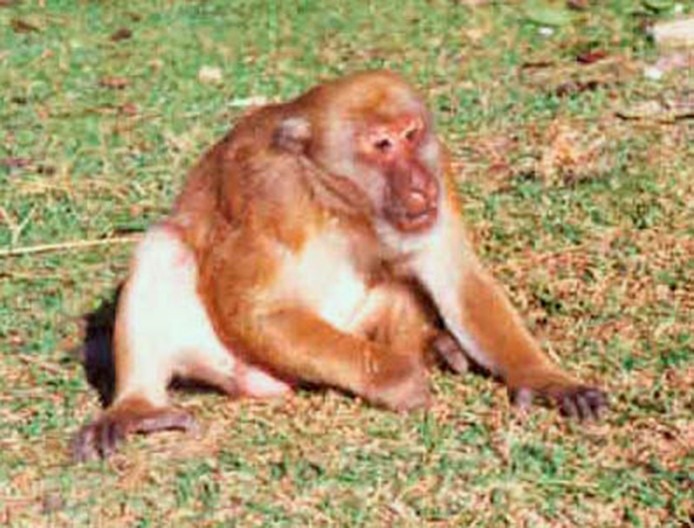Major Species and Invasive Species
Major Species and Invasive Species
Wildlife Conservation: Focus on Key Species
The chapter on Wildlife Conservation includes detailed descriptions of several significant species such as the Turtle, Big Cat, Crocodile, Vulture, Rhino, and Dolphin. While the topic is important from an ecological perspective, it is categorized as a high-effort, low-reward area for competitive exam preparation—especially in the context of the preliminary exams.
Historically, only one or two objective-type questions are asked from this chapter in the UPSC Prelims. Therefore, aspirants are advised not to spend excessive time memorizing exhaustive details or species-specific characteristics. Instead, the focus should be strategic and efficient.
Prioritize understanding the range and distribution of the key species mentioned. Develop a basic familiarity with their habitats and link these species with National Parks, Wildlife Sanctuaries, Ramsar Sites, and Biodiversity Hotspots where they are commonly found. This interlinking approach helps in better recall and application during the exam.
To streamline your study:
- Concentrate on species mentioned in recent government reports (e.g., State of Forest Report, ENVIS, etc.)
- Cross-reference with previous years’ Prelims questions to identify trends.
- Be aware of species covered under critical legislations like the Wildlife Protection Act, IUCN Red List, CITES appendices, and others.
Mammals
Common Threats to Wildlife: An Overview
Across ecosystems and continents, a variety of anthropogenic and natural threats continue to challenge the survival of numerous species. These threats often operate in combination, compounding the risks faced by already vulnerable flora and fauna. The most prevalent and concerning threats include:
- Habitat loss and fragmentation due to urbanization, deforestation, and infrastructure development.
- Plantation agriculture, which often replaces native ecosystems with monocultures.
- Pollution, including industrial runoff, plastic waste, and chemical contaminants.
- Invasive alien species that outcompete or prey upon native wildlife.
- Human encroachment into previously undisturbed ecosystems.
- Climate change, which affects migration patterns, breeding cycles, and habitat suitability.
- Depletion of freshwater resources and contamination of water bodies.
- Land degradation from overgrazing, deforestation, and unsustainable agricultural practices.
- Zoonotic diseases that may spread between wildlife and human populations.
- Illegal hunting and poaching, driven by trade in wildlife parts and traditional medicine practices.
Understanding and mitigating these threats is essential for any serious conservation effort, especially for critically endangered species.
1.Andaman White-Toothed Shrew (Crocidura andamanensis)
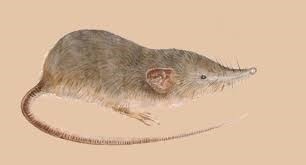
- Classification: Small, nocturnal, insectivorous mammal resembling a mouse.
- Distribution: Endemic to the Andaman Islands, specifically recorded on Narcondam Island, a remote volcanic island in the Andaman Sea.
- Habitat: Prefers tropical moist deciduous and evergreen forests.
- Conservation Status:
- IUCN: Critically Endangered
- Primary Threats: Vulnerable to natural disasters such as tsunamis, earthquakes, floods, and cyclones, due to its limited geographic range and island habitat.
2.Kashmir Stag / Hangul (Cervus hanglu hanglu)
- Classification: A sub-species of the Elk, it is the only Asiatic sub-species of the Red Deer.
- State Symbol: Declared the state animal of Jammu & Kashmir.
- Distribution: Historically found across Kashmir and parts of Himachal Pradesh’s Chamba district. Currently restricted to Dachigam National Park, near Srinagar.
- Habitat:
- Summer: Alpine meadows
- Winter: Lower valley areas
- Conservation Status:
- IUCN: Critically Endangered
- CITES: Appendix I
- CMS: Appendix I
- Wildlife Protection Act (WPA), 1972: Schedule I
- Major Threats:
- Poaching
- Habitat loss and fragmentation
- Overgrazing by domestic livestock
3.Large Rock Rat / Elvira Rat (Cremnomys elvira)
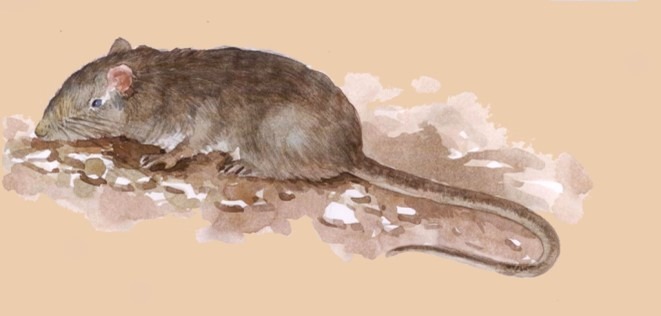
- Classification: Medium-sized, nocturnal, burrowing
- (fossorial) rodent.
- Distribution: Endemic to Kurumbapatti, near Salem district, Tamil Nadu, part of the Eastern Ghats.
- Habitat: Inhabits rocky terrain within tropical dry deciduous scrub forests.
- Conservation Status:
- IUCN: Critically Endangered
- Primary Threats:
- Habitat destruction due to activities like mining, quarrying, logging, and agricultural expansion.
4. Malabar Large-Spotted Civet (Viverra civettina)
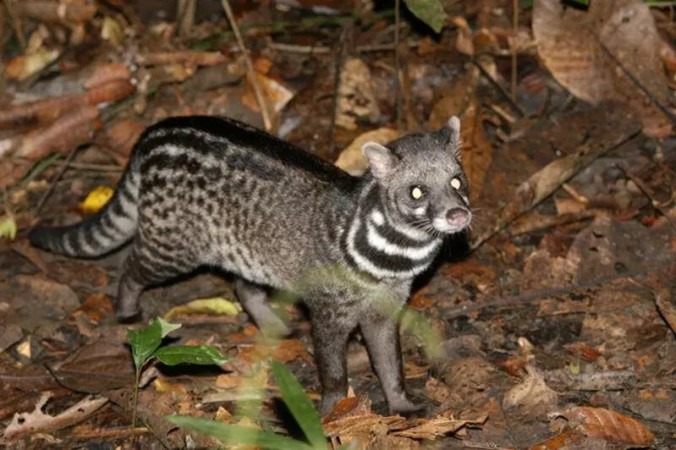
- Common Name: Malabar Civet
- Classification: Medium-sized, cat-like carnivorous mammal belonging to the Viverridae family.
- Distribution: Endemic to the southern Western Ghats, particularly in the coastal lowlands of Kerala.
- Habitat: Prefers lowland tropical forests and coastal swampy areas, although much of its former habitat has been lost or altered.
- Conservation Status:
- IUCN: Critically Endangered
- CITES: Appendix III
- Wildlife Protection Act (WPA), 1972: Schedule I
- Major Threats:
- Extensive habitat loss caused by the conversion of forests into agricultural land and monoculture plantations (e.g., rubber, arecanut).
- Lack of confirmed recent sightings has led to concerns of possible extinction in the wild.
5. Namdapha Flying Squirrel (Biswamoyopterus biswasi)

- Classification: A rare and elusive nocturnal gliding mammal, known only from a single specimen and location.
- Distribution: Known only from Namdapha National Park, Arunachal Pradesh—the largest protected area within the Eastern Himalayan biodiversity hotspot.
- Habitat: Lives along stream-adjacent dry deciduous montane forests, often in remote and inaccessible terrain.
- Conservation Status:
- IUCN: Critically Endangered
- WPA (India): Schedule II
- Major Threats:
- Habitat degradation from encroachment, logging, and shifting cultivation.
- Climate change impacting montane forest ecosystems and altering microhabitats essential for gliding and nesting.
6. Dhole (Cuon alpinus)
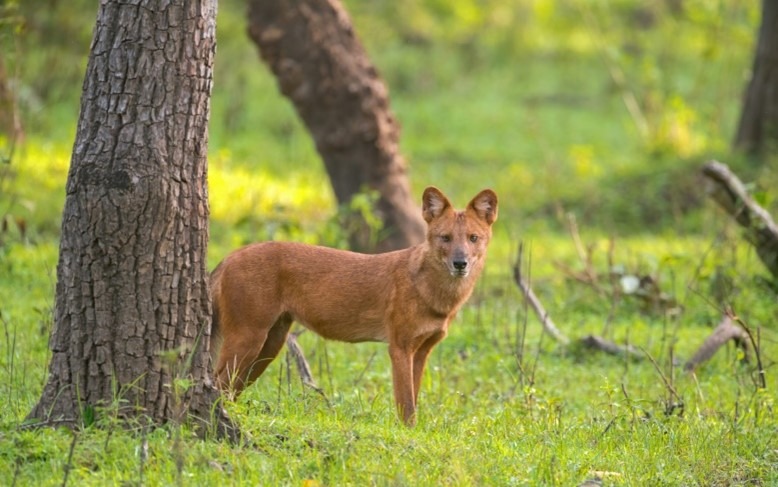
- Also Known As: Asiatic Wild Dog, Indian Wild Dog, Red Dog, Whistling Dog, or Red Wolf.
- Classification: Social, pack-living, dog-like carnivorous mammal of the Canidae family.
- Distribution: Found across various forested regions of India, including Western Ghats, Central India, Eastern Ghats, and the Northeast. Also seen in parts of Southeast Asia.
- Habitat: Inhabits tropical dry deciduous forests, evergreen forests, and high-altitude montane forests.
- Conservation Status:
- IUCN: Endangered
- WPA (India): Schedule II
- Unique Behavior:
- Dholes are known for their highly social behavior, hunting in coordinated packs.
- They communicate using a series of whistles and calls, giving rise to the name “whistling dog.”
- Major Threats:
- Habitat loss due to agriculture, infrastructure, and mining.
- Depletion of prey base in forests.
- Disease transmission from domestic dogs (e.g., canine distemper, rabies).
- Human-wildlife conflict, including persecution and accidental poisoning
7. Gee’s Golden Langur (Trachypithecus geei)
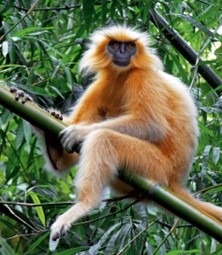
- Common Names: Golden Langur, Gee’s Golden Langur
- Classification: An Old World monkey (native to Asia and Africa), easily recognized by its lustrous golden-orange fur and long tail.
- Conservation Significance: Considered one of the most beautiful primates, the golden langur is also a flagship species for forest conservation in the region.
- Distribution:
- Found only in a narrow range between the Manas and Sankosh rivers in Western Assam (India) and Southern Bhutan.
- Key habitats include Manas National Park (India), Royal Manas National Park (Bhutan), and the Black Mountain region (Bhutan).
- Habitat:
- Thrives in a range of forest types, including moist evergreen, riverine, moist deciduous, temperate, and subalpine forests.
- Conservation Status:
- IUCN Red List: Endangered
- CITES: Appendix I
- Wildlife Protection Act, 1972 (India): Schedule I
- Major Threats:
- Inbreeding depression due to small and isolated populations, especially in fragmented habitats.
- Habitat fragmentation caused by deforestation, agriculture, and infrastructure development.
- Occasional conflict with humans, especially near settlements or tea plantations.
- Conservation Note:
- Several conservation programs are underway to maintain habitat corridors and strengthen population genetics.
8. Himalayan Brown Bear (Ursus arctos isabellinus)
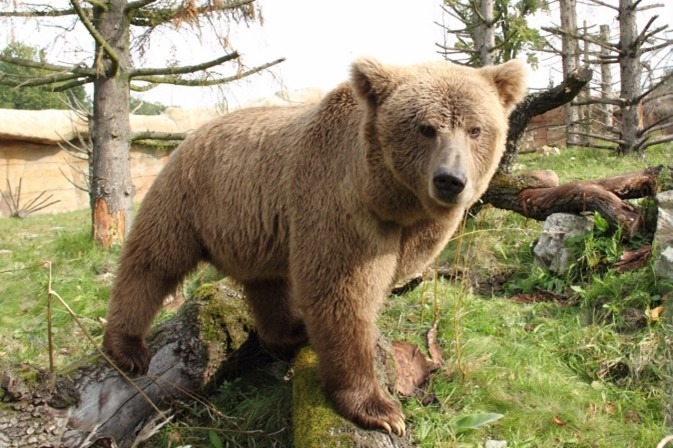
- Also Known As: Himalayan Red Bear or Isabelline Bear
- Classification: A high-altitude subspecies of the Brown Bear, which is one of the largest carnivorous mammals in Eurasia and North America.
- Unique Traits:
- Known for its reddish-brown coat, it is one of the largest carnivores found in the Himalayas.
- It is omnivorous, feeding on roots, fruits, insects, small mammals, and carrion.
- Hibernates during winter in dens dug into hillsides or caves.
- Distribution:
- Found in the high-altitude regions of Jammu & Kashmir, Himachal Pradesh, and Uttarakhand.
- Also present in Northern Pakistan, Nepal, the Tibetan Plateau, and parts of Central Asia.
- Habitat:
- Inhabits subalpine forests, alpine meadows, rocky slopes, and open highland pastures, generally above 3,000 meters elevation.
- Conservation Status:
- IUCN Red List: Endangered
- Wildlife Protection Act (India): Schedule I
- Major Threats:
- Conflict with pastoral communities, where bears are often killed to protect livestock.
- Poaching for body parts, particularly for the illegal trade in bear bile and fur.
- Habitat degradation due to expanding human settlements, tourism, and military activities in border regions.
- Conservation Note:
- Urgent need for conflict mitigation, anti-poaching enforcement, and habitat protection in alpine zones.
Conservation Implications
Both the Gee’s Golden Langur and the Himalayan Brown Bear exemplify the ecological richness and fragility of India’s biodiversity hotspots—the Eastern Himalayas and Western Ghats. Their continued survival hinges on:
- Habitat restoration
- Human-wildlife coexistence strategies
- Community engagement
- Strengthened wildlife protection laws
These species are not only biologically important but also serve as indicators of ecosystem health, making their conservation a national and global priority.
Among India’s lesser-known but ecologically significant species are the Hispid Hare and the Himalayan Musk Deer. Both are classified as Endangered (EN) on the IUCN Red List and are representative of the unique wildlife found in the Himalayan and sub-Himalayan ecosystems. Let’s take a closer look at their profiles:
Hispid Hare (Caprolagus hispidus)

- Also Known As: Assam Rabbit
- Classification: A rare species of hare, it is native to the grassland habitats of South Asia. Known for its short, coarse, and bristly fur, the Hispid Hare is adapted to dense grasslands, which offer it both food and cover.
- Distribution:
- Found in the Himalayan foothills across the Indian subcontinent.
- Countries of occurrence include India (Assam, West Bengal, Uttarakhand), Nepal, and Bhutan.
- Habitat:
- Prefers tall, wet grasslands, especially near river floodplains and forest edges.
- Sometimes found in early successional habitats such as abandoned agricultural fields that are reverting to wild vegetation.
- Conservation Status:
- IUCN Red List: Endangered
- CITES: Appendix I
- Wildlife Protection Act (India): Schedule I
- Major Threats:
- Habitat loss due to the conversion of grasslands into agricultural land, human settlements, and infrastructure.
- Frequent grassland burning reduces cover and affects breeding.
- Hunting and trapping, although less common now, still poses a localized threat.
- Conservation Note:
- The Hispid Hare is often seen as a flagship species for the conservation of grassland ecosystems in the Indian subcontinent, highlighting the urgent need to protect these rapidly disappearing habitats.
Himalayan Musk Deer (Moschus leucogaster)
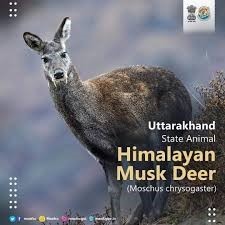
- Also Known As: White-Bellied Musk Deer
- Classification: A small, solitary and shy deer-like ungulate, the Himalayan Musk Deer is part of the Moschidae family, distinct from true deer (Cervidae) in several ways:
- Lack of antlers
- Presence of elongated upper canine teeth, especially in males
- Scent gland (musk pod) in males, used to produce musk, a substance highly valued in traditional medicine and the perfume industry.
- Distribution:
- Found in the high-altitude Himalayan regions of India (Uttarakhand, Himachal Pradesh, Sikkim), Nepal, Bhutan, Tibet (China), and northern Myanmar.
- Habitat:
- Occupies high alpine forests and scrublands, typically between 2,400 to 4,000 meters elevation.
- Prefers steep, rugged terrain with coniferous and mixed forests, and thickets near tree lines.
- Conservation Status:
- IUCN Red List: Endangered
- CITES: Appendix I
- Wildlife Protection Act (India): Schedule I
- Major Threats:
- Poaching for musk, which can sell for thousands of dollars per kilogram in the illegal market.
- Habitat degradation due to grazing, deforestation, and infrastructure development.
- Lack of effective monitoring, especially in remote and inaccessible habitats.
- Conservation Note:
- Due to high levels of illegal trade in musk, the Himalayan Musk Deer faces intense pressure. Protected areas like Nanda Devi Biosphere Reserve, Kedarnath Wildlife Sanctuary, and parts of Eastern Arunachal Pradesh are critical for its survival.
Why These Species Matter
Both the Hispid Hare and Himalayan Musk Deer serve as bioindicators of ecosystem health—one representing the endangered grassland ecosystems of the Terai and Dooars, and the other the high-altitude alpine forests of the Himalayas. Their conservation is crucial not only to maintain biodiversity but also to support the ecological integrity of their respective habitats.
Indian Hog Deer (Axis porcinus)
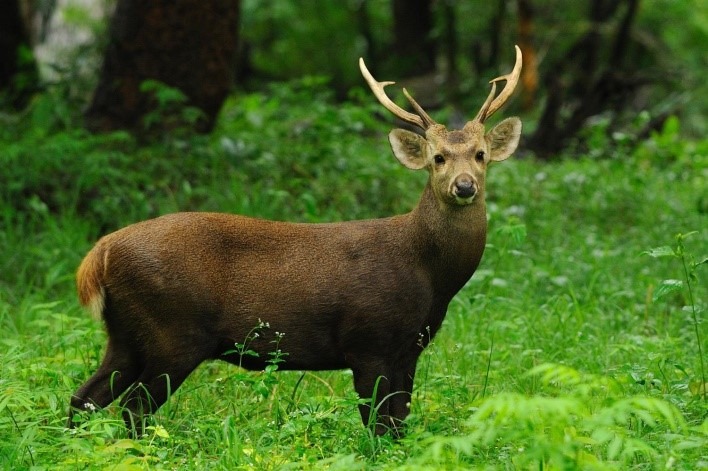
- Common Name: Indian Hog Deer
- Classification: A small, stocky deer with short legs and a pig-like running posture, hence the name “hog” deer.
- Distribution:
- Native to the Indo-Gangetic plains, its range spans across Pakistan, northern India, Nepal, and parts of mainland Southeast Asia.
- Strong populations are found in Assam, the Terai region of Uttarakhand, and select protected wetlands and grasslands.
- Habitat:
- Prefers wet, moist, or seasonally flooded tall grasslands, especially in river floodplains.
- Also found at the fringes of forests and wetlands.
- Conservation Status:
- IUCN Red List: Endangered
- CITES: Appendix III
- Wildlife Protection Act (India): Schedule III
- Major Threats:
- Habitat conversion for agriculture and settlements, leading to fragmentation of grasslands.
- Poaching and local hunting in parts of its range.
- Competition with livestock in floodplain areas.
- Conservation Note:
- Conservation efforts are focused on restoring floodplain ecosystems and maintaining protected corridors in areas like Kaziranga NP and Dudhwa NP.
Kondana Rat (Millardia kondana)
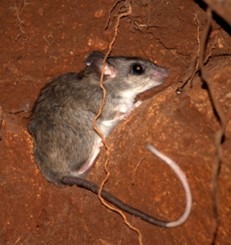
- Common Name: Kondana Rat
- Classification: A rare and elusive nocturnal, burrowing rodent, endemic to a very limited range in Maharashtra.
- Distribution:
- Found exclusively in Pune district, Maharashtra, particularly on the hilltop plateaus of Sinhagad, Torna, Rajgad, and Raireshwar.
- Habitat:
- Inhabits tropical and subtropical dry deciduous forests with rocky substrates and open grassy patches.
- Often seen in burrows under stones and in crevices along slopes and plateaus.
- Conservation Status:
- IUCN Red List: Endangered
- Major Threats:
- Unregulated tourism, especially trekking and camping, disturbing the fragile plateau ecosystem.
- Wood harvesting and firewood collection, which destroys burrowing and shelter sites.
- Invasive species and climate fluctuations, leading to reduced habitat quality.
- Conservation Note:
- As a point endemic species, the Kondana Rat is highly vulnerable. It requires urgent micro-level habitat protection and controlled tourism practices on these plateaus.
Lion-Tailed Macaque (Macaca silenus)
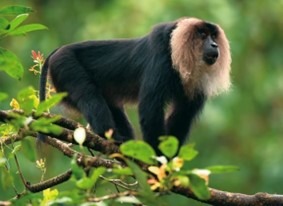
- Common Names: Lion-Tailed Macaque, Wanderoo
- Classification: An Old World monkey species, easily recognized by its silver-white mane surrounding a dark face and its tufted lion-like tail.
- Distribution:
- Endemic to the Western Ghats in southern India, particularly found in Kerala, Karnataka, and Tamil Nadu.
- Prominent populations exist in Silent Valley National Park, Anamalai Tiger Reserve, and Brahmagiri Hills.
- Habitat:
- Primarily inhabits tropical evergreen rainforests, though it may also be seen in monsoon and moist deciduous forests at higher elevations.
- An arboreal species that rarely descends to the ground and avoids human settlements, unlike other macaques.
- Conservation Status:
- IUCN Red List: Endangered
- CITES: Appendix I
- Wildlife Protection Act (India): Schedule I
- Major Threats:
- Deforestation and fragmentation of rainforest habitats due to logging, agriculture, and hydroelectric projects.
- Hunting in some tribal belts, and disturbance from eco-tourism.
- Habitat isolation, leading to small and genetically fragile populations.
- Conservation Note:
- The Lion-Tailed Macaque is a flagship species for Western Ghats conservation. Long-term survival requires corridor creation, habitat regeneration, and eco-sensitive zoning around reserves.
Conservation Priorities and Awareness
Each of these species plays a vital role in maintaining ecological balance within their respective ecosystems. Conservation priorities include:
- Protection of microhabitats like plateaus and tall grasslands.
- Community-based conservation and habitat restoration projects.
- Limiting human interference, particularly in biodiversity hotspots like the Western Ghats and Terai floodplains.
Nilgiri Tahr (Nilgiritragus hylocrius)
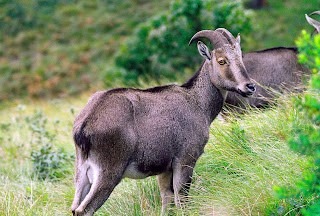
- Common Names: Nilgiri Ibex, Varaiaadu (in Tamil)
- Conservation Status:
- IUCN: Endangered
- WPA (India): Schedule I
- Distribution:
- Endemic to the Nilgiri Hills and the southern Western Ghats of Tamil Nadu and Kerala.
- The Eravikulam National Park, located in the Anamalai hills (Kerala), supports the largest population.
- Habitat:
- Prefers tropical montane grasslands, shola forests, and rocky escarpments at elevations above 1,200 meters.
- Ecological Significance:
- It is the state animal of Tamil Nadu.
- The only mountain ungulate in southern India among 12 species found in the country.
- Major Threats:
- Encroachment and degradation due to acacia and eucalyptus plantations.
- Habitat fragmentation, tourism, and invasive species.
Pygmy Hog (Porcula salvania)
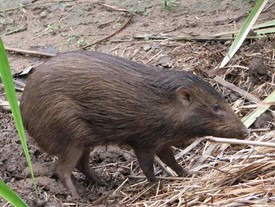
- Common Name: Pygmy Hog
- Classification: The smallest and rarest wild pig species in the world.
- Conservation Status:
- IUCN: Endangered
- WPA (India): Schedule I
- Distribution:
- Currently found only in Manas Wildlife Sanctuary, Assam.
- Historically distributed across the Terai grasslands of northern India and southern Nepal.
- Habitat:
- Requires dense, tall riverine grasslands, particularly those maintained by periodic flooding and burning.
- Ecological Note:
- It is an indicator species for healthy grassland ecosystems.
- Hosts the Pygmy Hog-Sucking Louse, a critically endangered parasite exclusive to this species.
- Threats:
- Rapid habitat loss, grassland degradation, and illegal hunting.
Red Panda (Ailurus fulgens)
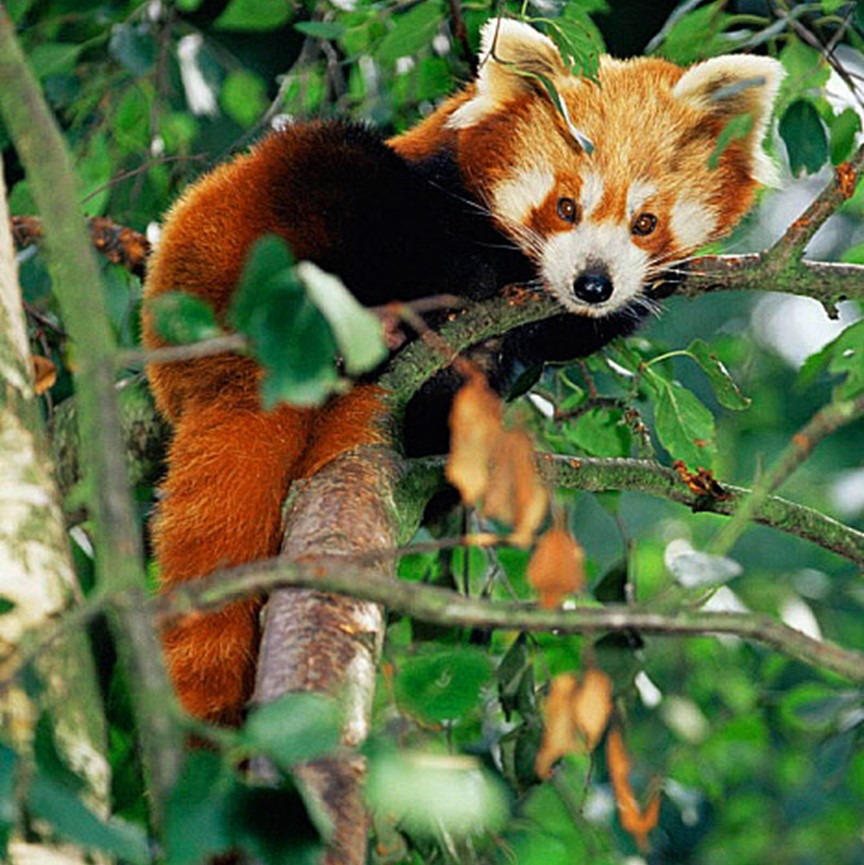
- Also Known As: Lesser Panda, Firefox
- Conservation Status:
- IUCN: Endangered
- CITES: Appendix I
- WPA (India): Schedule I
- Distribution:
- Native to the Eastern Himalayas and Southwest China.
- In India: Found in Sikkim, West Bengal (Darjeeling Hills), Arunachal Pradesh, and Meghalaya.
- Also found in Bhutan, Nepal, Myanmar, and China.
- Habitat:
- Occupies temperate montane forests with dense bamboo understory at elevations of 2,200–4,800 meters.
- Ecological Significance:
- State Animal of Sikkim.
- Functions as both an indicator and umbrella species, aiding the conservation of other Himalayan flora and fauna.
- Behavior:
- Arboreal, nocturnal, and crepuscular (active at dawn and dusk).
- Though classified as carnivorous, it primarily feeds on bamboo.
- Threats:
- Inbreeding depression, habitat fragmentation, and illegal pet trade.
Sangai (Rucervus eldii eldii)
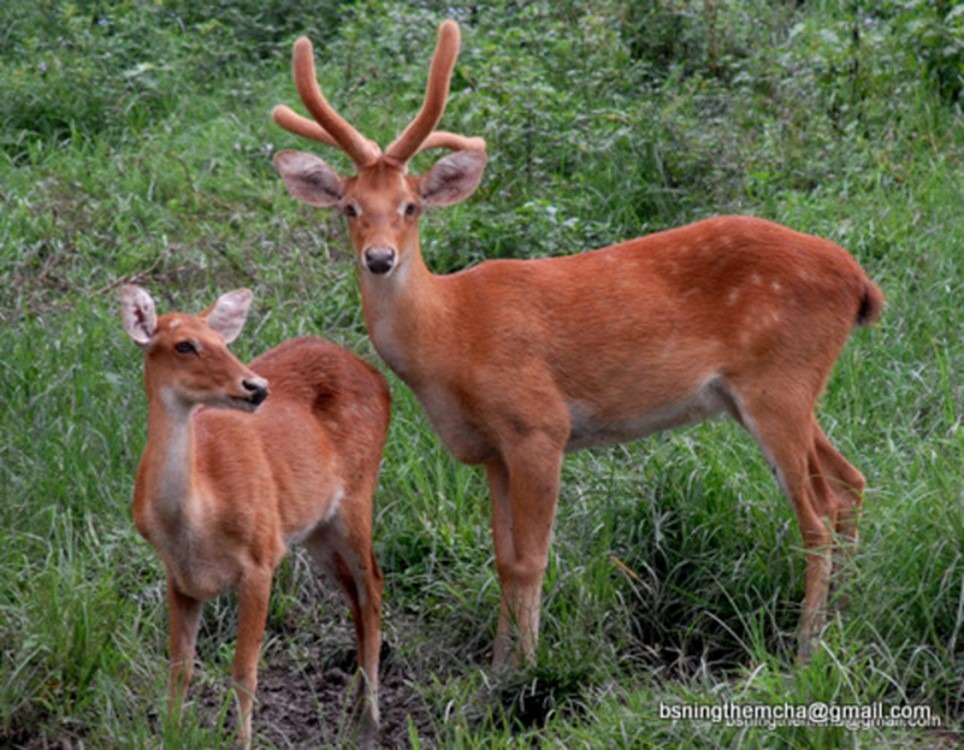
- Common Names: Brow-antlered Deer, Dancing Deer
- Conservation Status:
- IUCN: Endangered
- WPA (India): Schedule I
- Distribution:
- Endemic to Manipur, India.
- Confined to the Keibul Lamjao National Park — the world’s only floating national park on Loktak Lake.
- Habitat:
- Lives on phumdi — floating mats of vegetation found in Loktak Lake.
- Cultural and Ecological Importance:
- State animal of Manipur.
- Known for its graceful gait, which gives the impression that it is dancing on the floating vegetation.
- Threats:
- Habitat destruction, water management issues in Loktak Lake, and hunting.
Western Hoolock Gibbon (Hoolock hoolock)
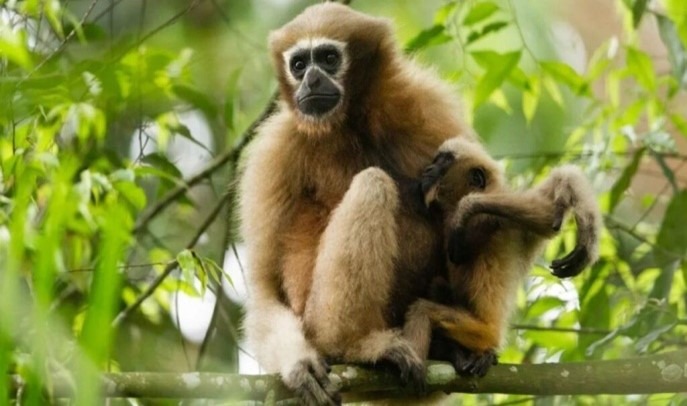
- Common Names: White-browed Gibbon
- Conservation Status:
- IUCN: Endangered
- CITES: Appendix I
- WPA (India): Schedule I
- Distribution:
- Found in Northeast India (Assam, Arunachal Pradesh, Meghalaya), Bangladesh, and Myanmar (west of the Chindwin River).
- Habitat:
- Inhabits tropical evergreen rainforests, semi-evergreen, and moist deciduous forests.
- Biological Traits:
- India’s only ape (lesser ape group).
- Known for its brachiation locomotion (swinging from branch to branch).
- Forms monogamous pairs and is highly territorial.
- Threats:
- Deforestation and fragmentation of forest habitats.
- Poaching and hunting, especially during local festivals or for traditional medicine.
Final Word: Conserving India’s Mammalian Diversity
These species are not just vital to India’s natural heritage—they are also ecological indicators, keystone species, or umbrella species that help sustain entire ecosystems. Their survival ensures the survival of countless other forms of life that share their habitats.
📌 Conservation Strategies:
- Community-based protection and eco-tourism in biodiversity hotspots.
- Habitat corridor creation and forest restoration.
- Enforcement of wildlife laws and local awareness campaigns.
Wild Water Buffalo (Bubalus arnee)

- Common Names: Asiatic Buffalo, Wild Buffalo
- Conservation Status:
- IUCN: Endangered globally
- India: Vulnerable (due to conservation status in India)
- WPA (India): Schedule I
- Ecological Importance: Acts as a keystone species in wetland ecosystems by maintaining open water areas and creating wallows used by other wildlife.
- Distribution:
- Native to South and Southeast Asia.
- In India: Primarily in Central India and the Northeast, especially Assam.
- Prominent habitats include Kaziranga National Park, Manas National Park, and Dibru-Saikhowa National Park.
- State Animal of Chhattisgarh.
- Habitat:
- Inhabits low-lying alluvial grasslands, including riverbanks, beels (oxbow lakes), and chaporis (sandy river islands).
- Threats:
- Hybridization with domestic buffalo.
- Habitat encroachment, diseases, and human-wildlife conflict.
Asian Black Bear (Ursus thibetanus)

- Common Names: Moon Bear, White-Chested Bear
- Conservation Status:
- IUCN: Vulnerable
- WPA (India): Schedule I
- Subspecies in India: Himalayan Black Bear
- Distribution:
- Found across Iran, the Indian subcontinent (especially northern and northeastern regions), China, Korea, Japan, and parts of Russia and Southeast Asia.
- Habitat:
- Prefers a wide variety of forest habitats, including temperate deciduous, broadleaf, and coniferous forests.
- In India, it thrives in the Himalayan foothills and North-Eastern forests.
- Behavior:
- Omnivorous and arboreal, often forages for fruits, nuts, insects, and small vertebrates.
- Threats:
- Habitat loss due to deforestation.
- Poaching for bile extraction and body parts used in traditional medicine.
Asian Small-Clawed Otter (Aonyx cinereus)

- Common Names: Oriental Small-Clawed Otter
- Conservation Status:
- IUCN: Vulnerable
- WPA (India): Schedule I
- Notable Features:
- Smallest otter species in the world.
- Distinguished by its dexterous front paws used for feeding and manipulation.
- Distribution:
- Native to South and Southeast Asia.
- In India: Found in the Himalayan region, Western Ghats, and Eastern Ghats.
- Habitat:
- Inhabits freshwater swamps, rivers, tidal pools, coastal lagoons, mangroves, and estuarine zones.
- Diet:
- Carnivorous, feeding on fish, crabs, mollusks, small mammals, and birds.
- Threats:
- Loss of wetland ecosystems.
- Pollution, damming of rivers, and illegal pet trade.
Barasingha (Rucervus duvaucelii)
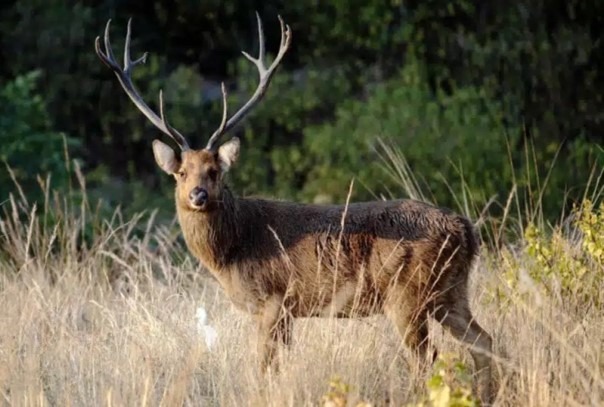
- Common Name: Swamp Deer
- Conservation Status:
- IUCN: Vulnerable
- WPA (India): Schedule I
- Significance:
- Known for its distinctive 12 or more tined antlers.
- Acts as a flagship species for swamp and tall grassland ecosystems.
- Distribution:
- Native to the Indian subcontinent.
- Found in isolated pockets in northern and central India, and southwestern Nepal.
- Prominent in Kanha Tiger Reserve (Madhya Pradesh).
- State Animal of Madhya Pradesh and Uttar Pradesh.
- Habitat:
- Prefers open forests, swampy grasslands, and mangrove ecosystems.
- Threats:
- Habitat degradation and competition with livestock.
- Poaching and disease transmission.
Bonnet Macaque (Macaca radiata)
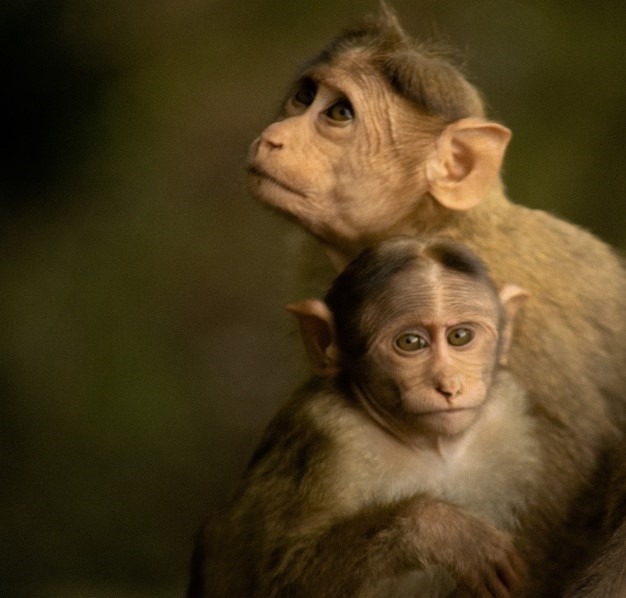
- Conservation Status:
- IUCN: Vulnerable
- WPA (India): Schedule II
- Distribution:
- Endemic to southern India, found south of the Godavari and Tapti rivers.
- Habitat:
- Highly adaptable species found in all types of forest ecosystems, agricultural areas, plantations, and urban landscapes.
- Behavior:
- Diurnal and social primate, often forming large troops.
- Known for its ability to co-exist with humans, though this has led to conflict and population stress.
- Threats:
- Habitat encroachment due to urbanization.
- Human-animal conflict and illegal captivity for entertainment
- Conservation Status:
Capped Langur (Trachypithecus pileatus)
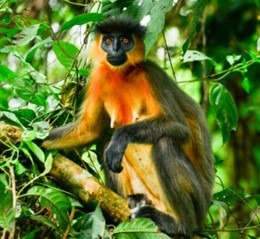
- Common Name: Capped Langur
- Conservation Status:
- IUCN: Vulnerable
- WPA (India): Schedule I
- Description:
- Capped Langur is a medium-sized arboreal primate known for its distinctive dark cap on the crown of its head. It is primarily herbivorous, feeding on leaves, flowers, fruits, and shoots.
- Distribution:
- Native to parts of Bangladesh, Bhutan, northeastern India, and Myanmar. In India, it occurs south of the Brahmaputra River in Assam, Arunachal Pradesh, Tripura, and nearby regions.
- Habitat:
- Found in a range of forest types, including subtropical evergreen, deciduous, bamboo forests, sub-montane ecosystems, and even teak plantations.
- Threats:
- Habitat destruction due to shifting cultivation and deforestation.
- Hunting and fragmentation of forest corridors.
Clouded Leopard (Neofelis nebulosa)

- Conservation Status:
- IUCN: Vulnerable
- WPA (India): Schedule I
- Significance:
- This elusive wild cat is named for its beautiful, cloud-shaped coat patterns. It is a tree-dwelling carnivore, skilled in climbing, and plays a top predator role in its habitat.
- State Animal of Meghalaya.
- Distribution:
- Native to Bangladesh, Bhutan, Nepal, China, India, and Southeast Asia. In India, it is distributed from Northeast states up to Valmiki Tiger Reserve in Bihar.
- Habitat:
- Prefers dense tropical and subtropical forests, including hill forests, rainforests, and secondary growth forests.
- Dampa Tiger Reserve (Mizoram) holds the highest known population density in the world.
- Threats:
- Habitat loss, hunting, and illegal wildlife trade.
- Fragmentation leading to genetic isolation.
- Conservation Status:
Dugong (Dugong dugon)

- Common Name: Sea Cow
- Conservation Status:
- IUCN: Vulnerable
- WPA (India): Schedule I
- Significance:
- The Dugong is a large herbivorous marine mammal, one of the only four extant species of the order Sirenia. It serves as an indicator species for coastal ecosystem health, especially seagrass beds.
- Distribution:
- Widespread across East Africa, South Asia, Southeast Asia, East Asia, and Australia. In India, populations are found in:
- Gulf of Mannar
- Palk Bay
- Gulf of Kutch
- Andaman and Nicobar Islands
- Habitat:
- Prefers shallow to medium-depth warm coastal waters with temperatures ranging from 15°C to 17°C, particularly areas rich in subtropical and tropical species of seagrass.
- Threats:
- Seagrass habitat degradation due to coastal development, pollution, and dredging.
- Bycatch in fishing nets, boat collisions, and marine traffic.
- Natural disasters like cyclones and tsunamis.
Eastern Hoolock Gibbon (Hoolock leuconedys)
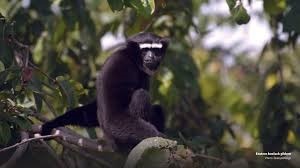
- Conservation Status:
- IUCN: Vulnerable
- WPA (India): Schedule I
- About the Species:
- One of the three recognized species of hoolock gibbons, this primate is known for its brachiation (arm-swinging) movement, loud territorial calls, and strong pair bonds.
- Distribution:
- Occurs primarily in Myanmar (east of the Chindwin River) and potentially in parts of eastern Arunachal Pradesh.
- Habitat:
- Found in a variety of forest ecosystems including:
- Evergreen forests
- Semi-evergreen and scrub forests
- Mountainous broadleaf forests
- Mixed pine forests
- Threats:
- Habitat fragmentation due to agriculture and infrastructure.
- Hunting and illegal wildlife trade.
- Conservation Status:
Fishing Cat (Prionailurus viverrinus)
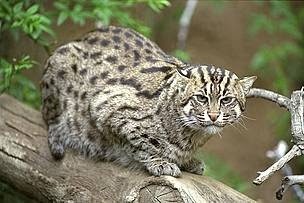
- Conservation Status:
- IUCN: Vulnerable
- WPA (India): Schedule I
- Description:
- The Fishing Cat is a medium-sized wild cat native to South and Southeast Asia. Known for its strong swimming abilities, this nocturnal cat preys mainly on fish, making it a critical species for aquatic ecosystem health. It is the state animal of West Bengal and also serves as an ambassador of Chilika, India’s oldest Ramsar Site.
- Distribution:
- Found in the plains of the Ganga, Yamuna, Brahmaputra, Sundarbans Delta, coastal wetlands along the Bay of Bengal, and Chilika Lagoon in India.
- Habitat:
- Prefers wetlands, mangroves, rivers, and streams.
- Threats:
- Habitat loss, especially due to shrimp farming.
- Unsustainable fishing practices and poaching.
- Conservation Efforts:
- The Fishing Cat Project (TFCP), active in West Bengal and Odisha, aims to research and conserve this species.
- Conservation Status:
Four-Horned Antelope (Tetracerus quadricornis)

- Conservation Status:
- IUCN: Vulnerable
- WPA (India): Schedule I
- Description:
- The Four-Horned Antelope, also known as Chousingha, is unique for its four horns—two on the top of the head and two further down, making it distinctive among bovids. This small, agile antelope is found in India and Nepal.
- Distribution:
- From the foothills of the Himalayas to the Deccan Plateau, it thrives in open, dry deciduous forests and grassy areas.
- Habitat:
- Prefers undulating, hilly terrain, often found near water sources.
- Threats:
- Hunting and competition with livestock for resources.
- Conservation Status:
Gaur (Bos gaurus)
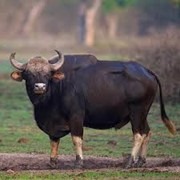
- Conservation Status:
- IUCN: Vulnerable
- WPA (India): Schedule I
- Description:
- The Gaur, or Indian Bison, is the largest of the wild cattle species. This magnificent animal is known for its muscular build and powerful horns. The domesticated version of the Gaur is the Gayal or Mithun. It is the highlight of various national parks like Wayanad, Nagarhole, and Mudumalai in India.
- Distribution:
- Found in the Himalayan foothills, NE India, Eastern Ghats, and Western Ghats.
- Habitat:
- Prefers a wide range of forest types, including evergreen, semi-evergreen, moist deciduous, and dry deciduous forests.
- Threats:
- Poaching for their meat and horns.
- Habitat loss and fragmentation.
- Conservation Status:
Mainland Serow (Capricornis sumatraensis)
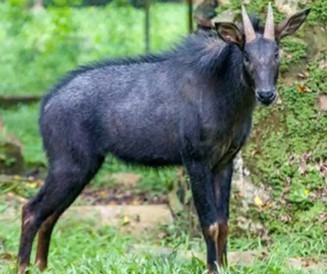
- Conservation Status:
- IUCN: Vulnerable
- WPA (India): Schedule I
- Description:
- The Mainland Serow is a medium-sized goat-antelope-like mammal. Its cousin, the Himalayan Serow, is the state animal of Mizoram. Known for its agility on steep slopes, the serow is native to Himalayan regions.
- Distribution:
- Found in the Himalayas, NE India, and parts of SE Asia.
- Habitat:
- Prefers rugged mountain slopes with steep hills.
- Threats:
- Over poaching and hunting for their meat and skins.
- Habitat loss due to encroachment.
- Conservation Status:
Nilgiri Langur (Trachypithecus johnii)
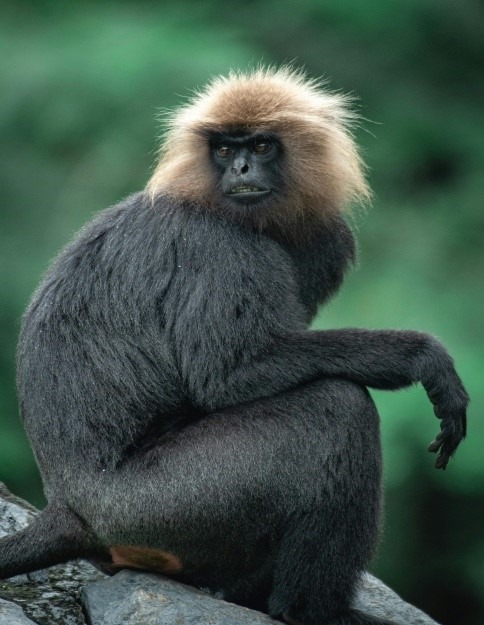
- Conservation Status:
- IUCN: Vulnerable
- WPA (India): Schedule I
- Description:
- The Nilgiri Langur, also known as the Nilgiri Leaf Monkey, is an endemic species found only in the Nilgiri Hills of southern India. It is renowned for its dense black fur with a white patch on the sides.
- Distribution:
- Found only in the Western Ghats, particularly in the states of Kerala, Tamil Nadu, and Karnataka.
- Habitat:
- Prefers evergreen, semi-evergreen, and montane evergreen forests.
- Threats:
- Habitat loss due to deforestation.
- Hunting for its fur.
- Conservation Status:
Nilgiri Marten (Martes gwatkinsii)

- Conservation Status:
- IUCN: Vulnerable
- WPA (India): Schedule I
- Description:
- The Nilgiri Marten is a small carnivorous mammal native to the Western Ghats. It is recognized for its beautiful fur, which has led to hunting pressures.
- Distribution:
- Native to the Western Ghats in southern India.
- Habitat:
- Evergreen forests and montane forest-grassland ecosystems.
- Threats:
- Habitat destruction due to commercial forestry.
- Poaching for its fur.
- Conservation Status:
Sambar (Rusa unicolor)

- Conservation Status:
- IUCN: Vulnerable
- WPA (India): Schedule I
- Description:
- The Sambar is a large deer species, one of the largest in India. It is primarily nocturnal and has an incredibly varied diet. Known for its impressive antlers, the Sambar is crucial in maintaining the balance of the forest ecosystems.
- State Animal of Odisha.
- Distribution:
- Found throughout India, except in the arid deserts of the northwest and high-altitude Himalayas.
- Habitat:
- Found in moist and dry tropical forests, savannahs, and grasslands near water sources.
- Conservation Status:
The Way Forward: Protecting India’s Vulnerable Mammals
The Vulnerable species listed above are a crucial part of India’s rich biodiversity. Protecting these species from extinction requires combined efforts in habitat conservation, anti-poaching measures, and community-based conservation programs.
Conservation Recommendations:
- Enhance Protected Area Networks: Ensure better management and larger connected habitats for wildlife.
- Community Involvement: Empower local communities to become active participants in wildlife protection and sustainable tourism.
- Research & Monitoring: Support ongoing wildlife research to understand the needs of vulnerable species and improve conservation methods.
Smooth-Coated Otter (Lutrogale perspicillata)
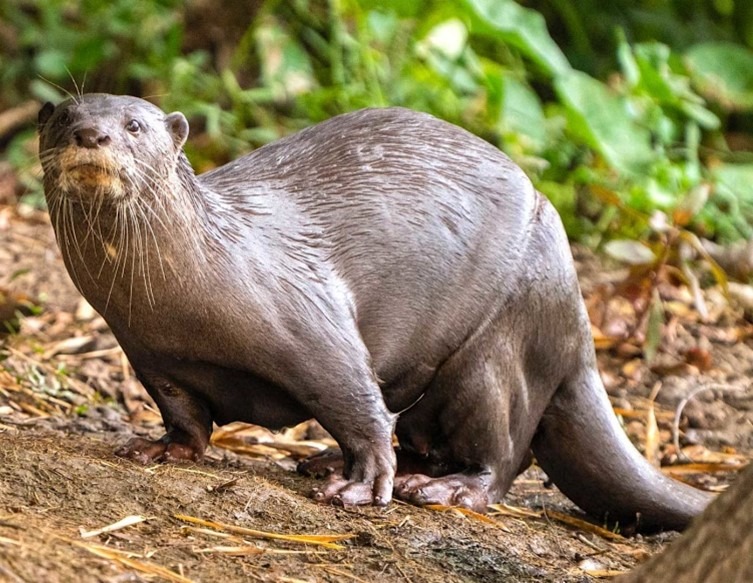
- Conservation Status:
- IUCN: Vulnerable
- WPA (India): Schedule I
- Description:
- The Smooth-Coated Otter is a semi-aquatic mammal native to the Indian subcontinent and Southeast Asia. Known for its playful behavior, it primarily feeds on fish, but also hunts small mammals, birds, and other aquatic creatures. It is a carnivorous otter species, requiring healthy freshwater ecosystems for survival.
- Distribution:
- Found throughout India, except for the hot deserts, high-altitude Himalayas, and the central Deccan Plateau.
- Habitat:
- Prefers freshwater swamps, rivers, mangroves, tidal pools, coastal lagoons, and estuaries.
- Threats:
- Pollution of water bodies.
- Habitat loss due to urbanization and industrial activities.
- Poaching for their pelts.
- Conservation Status:
Snow Leopard (Panthera uncia)
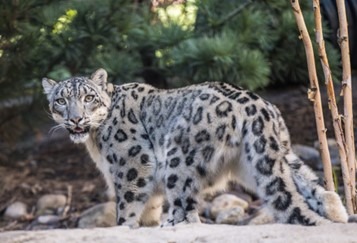
- Conservation Status:
- IUCN: Vulnerable
- WPA (India): Schedule I
- Description:
- Known as the “Ghost of the Mountains”, the Snow Leopard is an elusive big cat and a keystone species for the high-altitude ecosystems of the Himalayas. As an indicator species, it reflects the health of its mountainous environment. It is also considered a flagship species, symbolizing conservation efforts for the unique habitats of the Himalayan region.
- Distribution:
- Found in the mountain ranges of Central Asia and South Asia. In India, it primarily inhabits the Himalayan region.
- Habitat:
- Lives in alpine and subalpine zones characterized by rugged mountain terrain.
- Threats:
- Habitat loss due to climate change and human encroachment.
- Poaching for its valuable fur and bones.
- Unregulated tourism that disturbs its natural habitat.
- Competition with livestock for grazing areas.
- Conservation Status:
Stump-Tailed Macaque (Macaca arctoides)
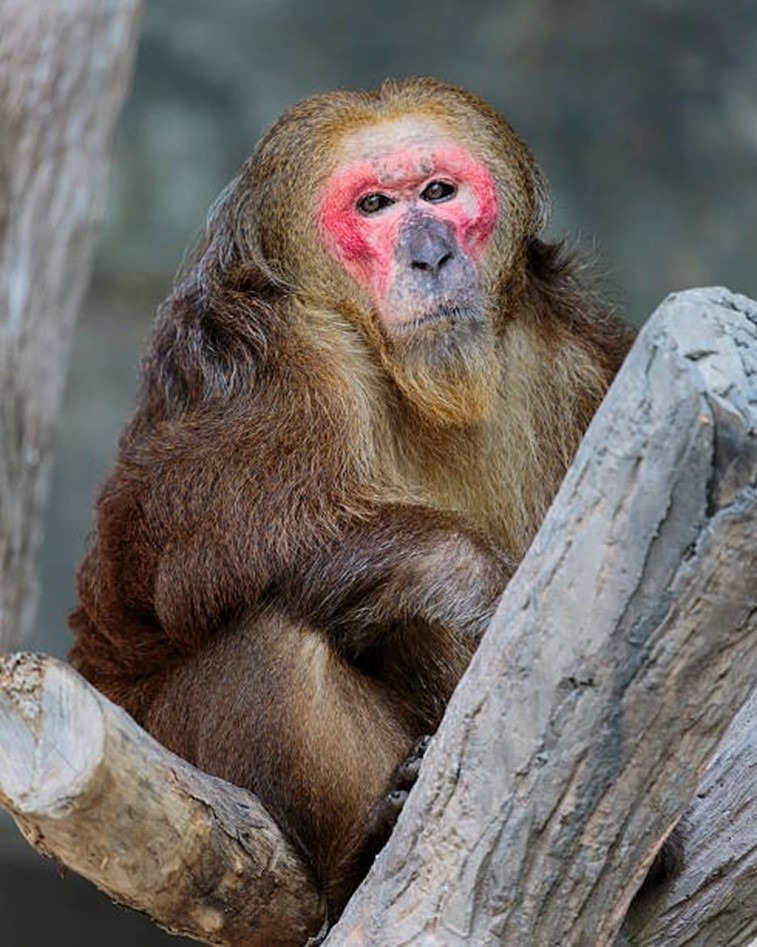
- Conservation Status:
- IUCN: Vulnerable
- WPA (India): Schedule I
- Description:
- The Stump-Tailed Macaque, also known as the Bear Macaque, is a medium-sized macaque native to South Asia and Southeast Asia. This diurnal primate is known for its distinctive stubby tail and its adaptability to both arboreal and terrestrial lifestyles.
- Distribution:
- Found in northeastern India, particularly south of the Brahmaputra River.
- Habitat:
- Prefers tropical semi-evergreen forests, wet evergreen forests, and moist deciduous forests.
- Threats:
- Habitat destruction due to deforestation.
- Hunting for its meat and use in traditional medicine.
- Conservation Status:
Takin (Budorcas taxicolor)
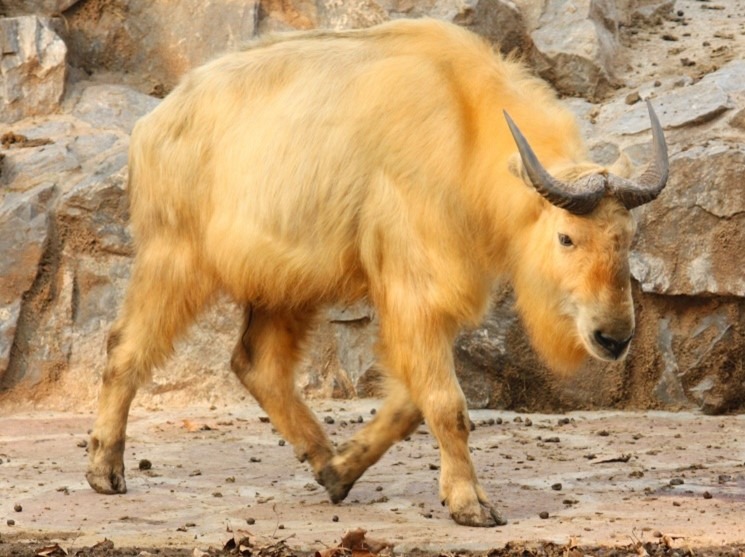
- Conservation Status:
- IUCN: Vulnerable
- WPA (India): Schedule I
- Description:
- The Takin, also known as the Cattle Chamois or Gnu Goat, is a large herbivorous mammal related to goats and antelopes. It has a muscular body and a distinctive face that combines features of goats and cattle. This large ungulate is well adapted to life in the rugged Himalayan regions.
- Distribution:
- Found in the Eastern Himalayas and parts of China, with populations in Arunachal Pradesh and Sikkim in India.
- Habitat:
- Inhabits forested valleys and rocky alpine zones at high altitudes.
- Threats:
- Poaching for its horns and meat.
- Habitat loss due to logging and human encroachment.
- Conservation Status:
Argali (Ovis ammon)
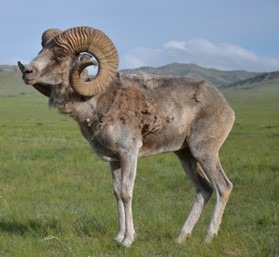
- Conservation Status:
- IUCN: Near Threatened
- WPA (India): Schedule I
- Description:
- The Argali is the world’s largest wild sheep, renowned for its massive spiral horns. These impressive creatures are a symbol of high-altitude ecosystems, and their populations are limited to some of the most remote and rugged regions of the world.
- Distribution:
- Found in Central Asia, the Himalayas, Tibet, and the Altai Mountains. In India, it is confined to Ladakh, with occasional sightings in Spiti (Himachal Pradesh) and northern Sikkim.
- Habitat:
- Prefers mountainous regions, steppe valleys, and rocky outcrops.
- Threats:
- Poaching for their valuable horns and meat.
- Habitat destruction due to mining and infrastructure development.
- Conservation Status:
Asiatic Golden Cat (Catopuma temminckii)
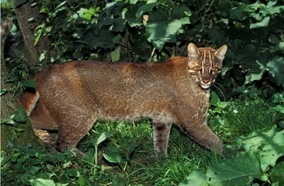
- Conservation Status:
- IUCN: Near Threatened
- WPA (India): Schedule I
- Description:
- The Asiatic Golden Cat is a medium-sized wild cat found in India and Southeast Asia. It has a golden to grayish-brown coat and is known for its elusive nature. Recent sightings of the melanistic (black) variety in West Bengal have drawn attention to this rare species.
- Distribution:
- In India, it is found only in the northeastern states.
- Habitat:
- Thrives in tropical, subtropical, and mixed evergreen forests, as well as dry deciduous forests.
- Threats:
- Habitat loss and fragmentation.
- Poaching for the illegal pet trade and traditional medicine.
- Conservation Status:
Assamese Macaque (Macaca assamensis)
- Conservation Status:
- IUCN: Near Threatened
- WPA (India): Schedule I
- Description:
- The Assamese Macaque is an Old World monkey native to the Indian subcontinent. This diurnal, omnivorous species is both arboreal and terrestrial, often seen in small groups. It plays a key role in seed dispersal, contributing to the regeneration of its forest habitat.
- Distribution:
- Found in NE India, including Assam, West Bengal, and Uttarakhand.
- Habitat:
- Prefers tropical, subtropical, semi-evergreen forests, and dry deciduous forests, including montane areas.
- Threats:
- Hunting for the illegal pet trade.
- Invasive species and diseases affecting their population.
- Conservation Status:
Conservation Challenges and Solutions
Many of the Near Threatened and Vulnerable species highlighted here face growing threats from human activities such as deforestation, habitat encroachment, and poaching. However, their conservation offers an opportunity to protect entire ecosystems. Efforts must be intensified, including:
Key Conservation Efforts:
- Increased Protection of Habitats: Establish more protected areas and ensure strict enforcement of conservation laws.
- Community Involvement: Empower local communities to act as stewards of the environment through eco-tourism, sustainable practices, and education.
- Targeted Species Conservation Plans: Develop specific action plans for each species, with a focus on habitat restoration and reducing human-wildlife conflict.
Mammal – Near Threatened (NT) – Chiru (Tibetan Antelope)
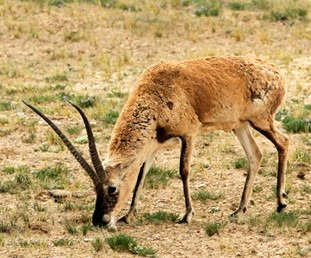
- Scientific Name:
- Pantholops hodgsonii
- Description:
- The Chiru, also known as the Tibetan Antelope, is a medium-sized bovid renowned for its fine underfur called shahtoosh, which has been highly valued in the textile industry.
- Distribution:
- Primarily native to the Tibetan Plateau, with significant populations in China’s Chang Tang region. In India, they are found in the high-altitude areas of Ladakh, including the Karakoram (Nubra Shyok) Wildlife Sanctuary and Changthang Cold Desert Wildlife Sanctuary.
- Habitat:
- Inhabits alpine and desert steppes, as well as meadows at elevations ranging from 3,250 to 5,500 meters. These regions are characterized by harsh climates, with temperatures dropping as low as -40°C and experiencing heavy snowfall.
- Threats:
- Poaching: Historically hunted extensively for shahtoosh, leading to significant population declines. Each shahtoosh shawl requires wool from 3–5 antelopes, and the trade has been internationally banned under CITES since 1975.
- Habitat Loss: Infrastructure development and human encroachment have led to habitat fragmentation.
- Climate Change: Alters the delicate balance of their high-altitude ecosystems, affecting food availability and habitat conditions.
- Conservation Status:
- IUCN Red List: Near Threatened
- CITES: Appendix I
- Population Trend: Once reduced to approximately 65,000 in the 1990s, conservation efforts have helped increase numbers to an estimated 100,000–150,000 mature individuals.
- Scientific Name:
Mammal – Near Threatened (NT) – False Killer Whale

- Scientific Name:
- Pseudorca crassidens
- Description:
- Despite its name, the False Killer Whale is a large oceanic dolphin species known for its social behavior and complex vocalizations.
- Distribution:
- Found in tropical and subtropical oceans worldwide, including the Indian Ocean. They prefer deep offshore waters but are occasionally sighted near coastlines.
- Habitat:
- Inhabit offshore waters deeper than 1,000 meters, often in areas with abundant prey.
- Threats:
- Bycatch: Frequently entangled in fishing gear, leading to injury or death.
- Pollution: Accumulation of pollutants like heavy metals and PCBs affects their health and reproductive success.
- Prey Depletion: Overfishing reduces the availability of their primary food sources.
- Conservation Status:
- IUCN Red List: Near Threatened
- CITES: Appendix II
- Conservation Efforts:
- Protected under various national and international regulations, with ongoing research and monitoring programs to mitigate threats.
- Scientific Name:
Mammal – Near Threatened (NT) – Grey Slender Loris

- Scientific Name:
- Loris lydekkerianus
- Description:
- The Grey Slender Loris is a small, nocturnal primate known for its slow movements and large, reflective eyes. It plays a crucial role in pest control by feeding on insects.
- Distribution:
- Endemic to India and Sri Lanka. In India, they are primarily found between the Tapti and Godavari rivers and along the southern coast.
- Habitat:
- Occupies a variety of habitats, including tropical rainforests, dry semi-deciduous forests, scrublands, swamps, acacia, bamboo, and montane forests.
- Threats:
- Habitat Loss: Deforestation and land conversion for agriculture and urban development.
- Illegal Wildlife Trade: Captured for the pet trade and traditional medicine.
- Infrastructure Development: Activities like illegal red sand mining and brick-making pose significant threats, especially near protected areas like the Kadavur Slender Loris Sanctuary.
- Scientific Name:
Conservation Status:
- IUCN Red List: Near Threatened
- Wildlife Protection Act (India): Schedule I
- Conservation Initiatives:
- The Kadavur Slender Loris Sanctuary in Tamil Nadu, established in October 2022, spans 118.06 km² across Karur and Dindigul districts, providing a protected habitat for this species.
Grizzled Giant Squirrel (Ratufa macroura) – Near Threatened (NT)

- The Grizzled Giant Squirrel, also known as the Sri Lankan Giant Squirrel, is a large tree-dwelling rodent endemic to India and Sri Lanka. In India, it is primarily found in the riparian forests of Tamil Nadu and Kerala. Notably, the Chinnar Wildlife Sanctuary in Kerala hosts a significant population, with estimates indicating about 260 individuals within 35 km² of riparian vegetation, reflecting a positive trend from previous counts.
- Habitat:
- Prefers tropical dry deciduous and montane forests, especially along riverine areas.
- Threats:
- Habitat loss due to deforestation, agricultural expansion, and human encroachment.
Himalayan Goral (Naemorhedus goral) – Near Threatened (NT)

- The Himalayan Goral is a small, agile bovid species inhabiting the steep, rugged terrains of the Himalayas. In India, it is found across the Himalayan region, including states like Sikkim and Arunachal Pradesh.
- Habitat:
- Steep mountainous areas with rocky terrain, often near cliffs and sometimes in evergreen forests.
- Threats:
- Hunting for meat and competition with livestock for grazing resources.
Himalayan Tahr (Hemitragus jemlahicus) – Near Threatened (NT)
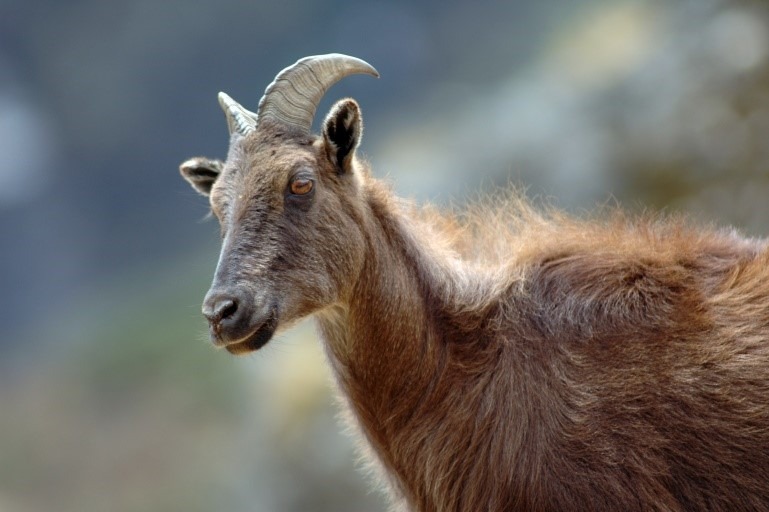
- The Himalayan Tahr is a large, even-toed ungulate native to the Himalayan ranges. In India, it is found in Jammu & Kashmir, Himachal Pradesh, Uttarakhand, and Sikkim.
- Habitat:
- Steep rocky mountain slopes, often amidst rhododendron forests.
- Threats:
- Uncontrolled hunting and habitat loss due to deforestation.
Indian Wild Ass (Equus hemionus khur) – Near Threatened (NT)
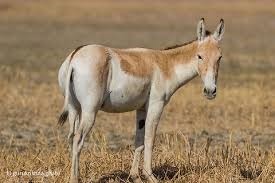
- The Indian Wild Ass, or Khur, is a subspecies of the Asiatic wild ass, primarily found in the Little Rann of Kutch and surrounding areas in Gujarat, India. Recent censuses have shown a population increase, with over 4,800 individuals recorded in and around the Indian Wild Ass Sanctuary.
- Habitat:
- Semi-desert and grassland areas.
- Threats:
- Habitat loss due to agriculture, development, salt extraction activities, invasive species like Prosopis juliflora, and competition with livestock.
Malayan Giant Squirrel (Ratufa bicolor) – Near Threatened (NT)
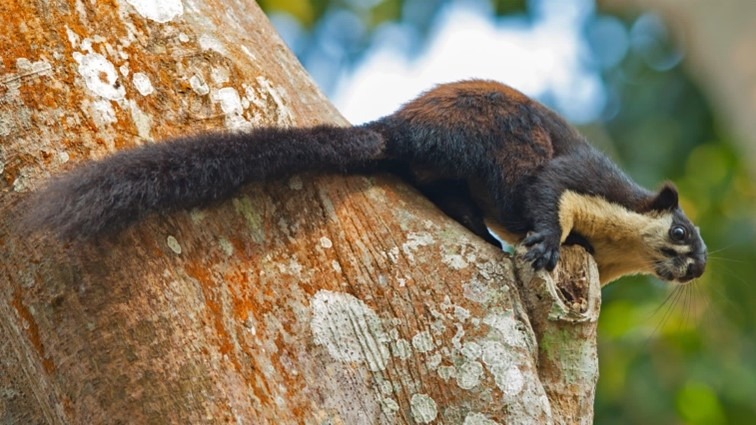
- The Malayan Giant Squirrel, also known as the Black Giant Squirrel, is one of the largest tree squirrels, native to the Indo-Malayan region. In India, it is found in the northeastern states.
- Habitat:
- Tropical and subtropical montane evergreen forests, and dry deciduous forests.
- Threats:
- Hunting and habitat loss due to practices like jhum (shifting) agriculture .
Marbled Cat (Pardofelis marmorata) – Near Threatened (NT)
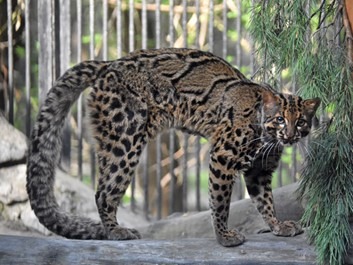
- The Marbled Cat is a small wild cat with a distinctive marbled coat pattern, native to the eastern Himalayas and Southeast Asia. In India, it occurs in the Himalayan foothills and hilly areas of Northeast India.
- Habitat:
- Moist deciduous-evergreen forests, including mixed forests, clearings, and secondary growth areas.
Markhor (Capra falconeri) – Near Threatened (NT)
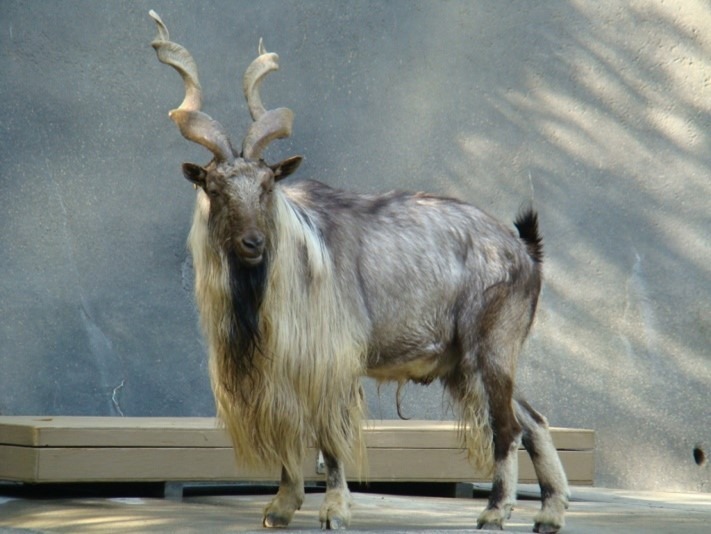
- The Markhor, also known as the Screw-horned Goat, is a large wild goat species and the national animal of Pakistan. In India, it is found in Jammu & Kashmir, particularly in areas like Shopian, the Pir Panjal range, and Kazinag Uri.
- Habitat:
- Mountainous terrain with steep cliffs.
- Threats:
- Habitat fragmentation due to human interference and infrastructure projects.
Rusty-Spotted Cat (Prionailurus rubiginosus) – Near Threatened (NT)
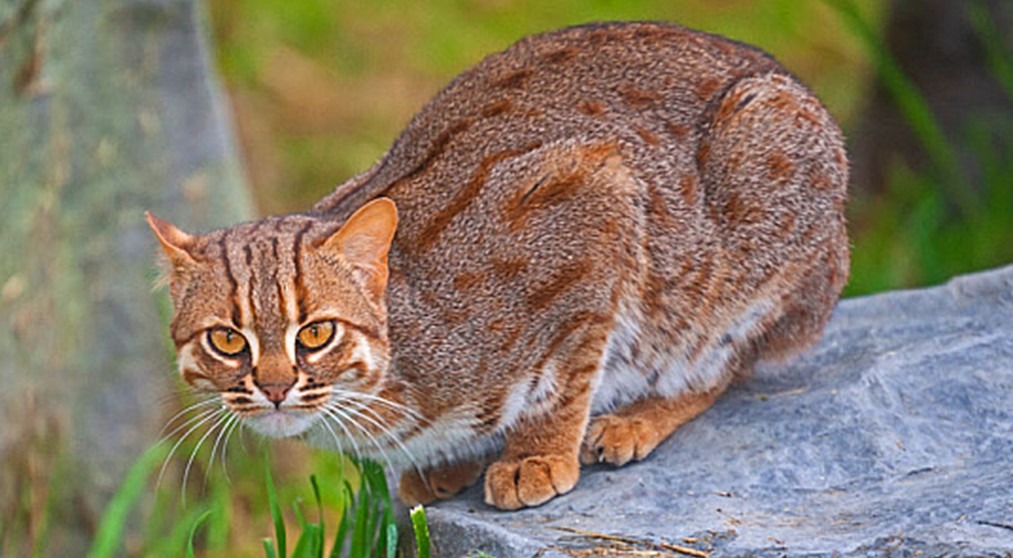
- The Rusty-Spotted Cat is one of the smallest wild cat species, native to India and Sri Lanka. In India, it is found in various regions except for West Bengal and Northeast India.
- Habitat:
- Moist and dry deciduous forests, scrublands, and grasslands; typically absent in evergreen forests.
Siberian Ibex (Capra sibirica) – Near Threatened (NT)
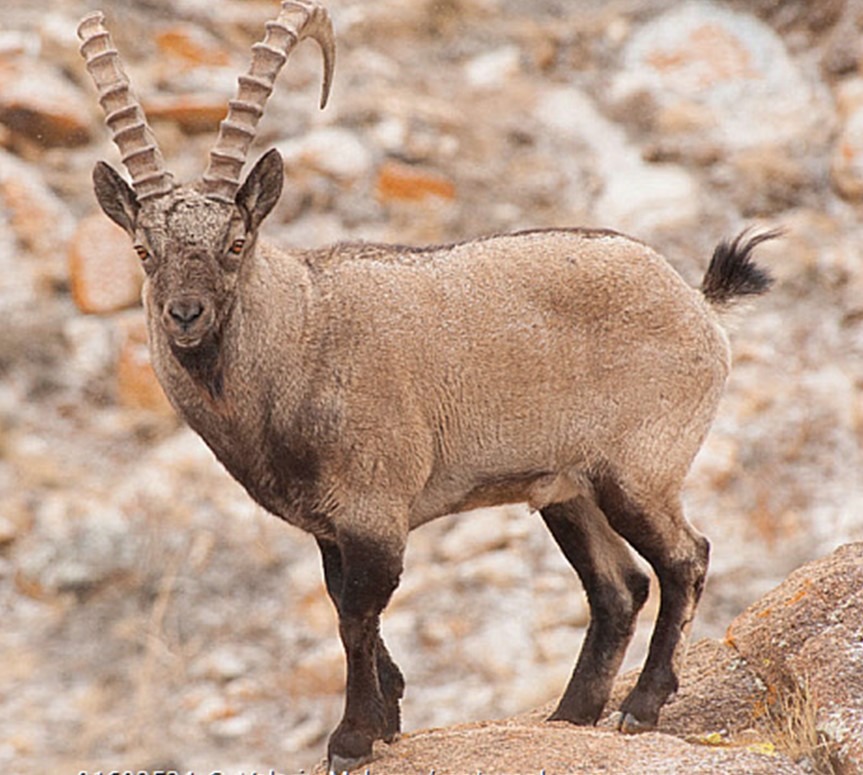
- The Siberian Ibex is a species of wild goat native to Central Asia. In India, it is found in the mountain ranges of Jammu & Kashmir, Ladakh, and Himachal Pradesh. Notably, Ladakh hosts approximately 6,000 individuals, with additional populations in various wildlife sanctuaries.
- Habitat:
- Mountainous regions with rugged terrains.
Mammal – LC – Chinkara
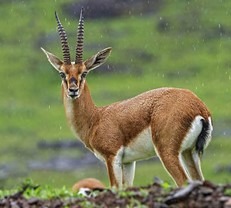
- The Chinkara, also known as the Indian Gazelle, is the smallest species of Asiatic antelope. It is a graceful and agile animal, well-adapted to life in dry and arid landscapes. Chinkaras are known for their speed and shy nature, typically avoiding human settlements.
- Subspecies:
- There are six recognized subspecies of Indian gazelle, with Deccan Chinkara and Gujarat Chinkara occurring in India.
- Distribution:
- Deccan Chinkara: From the Ganges Valley (west of West Bengal) down to the Deccan Plateau.
- Gujarat Chinkara: Found in the Thar Desert, Rann of Kutch, Kathiawar Peninsula, and Saurashtra region of Gujarat.
- Habitat:
- Prefers arid and semi-arid regions, including deserts, dry scrublands, and open deciduous forests. They inhabit terrain with sparse vegetation and are rarely found near human settlements.
Mammal – LC – Chital (Spotted Deer)

- The Chital, also known as Spotted Deer or Axis Deer, is one of the most common and widely distributed deer species in India. Males are distinguished by their large, branched antlers and characteristic white spots on a reddish-brown coat.
- Distribution:
- Found throughout the Indian subcontinent, except in the high-altitude Himalayan regions and the extremely arid zones of Northwest India.
- Habitat:
- Adaptable to a wide range of habitats including deciduous forests, grasslands, scrublands, and areas near water bodies. It tends to avoid dense evergreen forests and deserts.
- Ecology:
- They often form herds and are known to coexist with other herbivores like sambar and langurs, creating a symbiotic vigilance against predators.
Mammal – LC – Golden Jackal
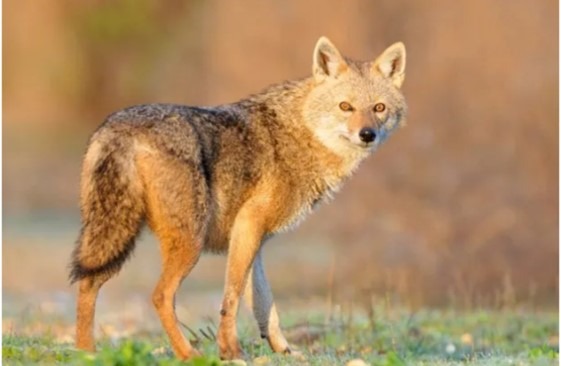
- The Golden Jackal (Common Jackal) is a highly adaptable wolf-like canid native to parts of Europe and Asia. It is an opportunistic omnivore, feeding on a wide variety of food sources including small mammals, birds, fruits, and human refuse.
- Distribution:
- Found across Southeast Europe, Central Asia, the Middle East, South Asia, and parts of Southeast Asia. In India, it is widespread in both rural and peri-urban areas.
- Habitat:
- Occupies diverse habitats such as dry scrublands, deciduous forests, mangroves, agricultural fields, and even near human settlements.
- Ecological Role:
- Acts as a scavenger and plays a key role in the ecosystem by helping to control rodent populations and cleaning up carcasses.
Mammal – LC – Humpback Whale
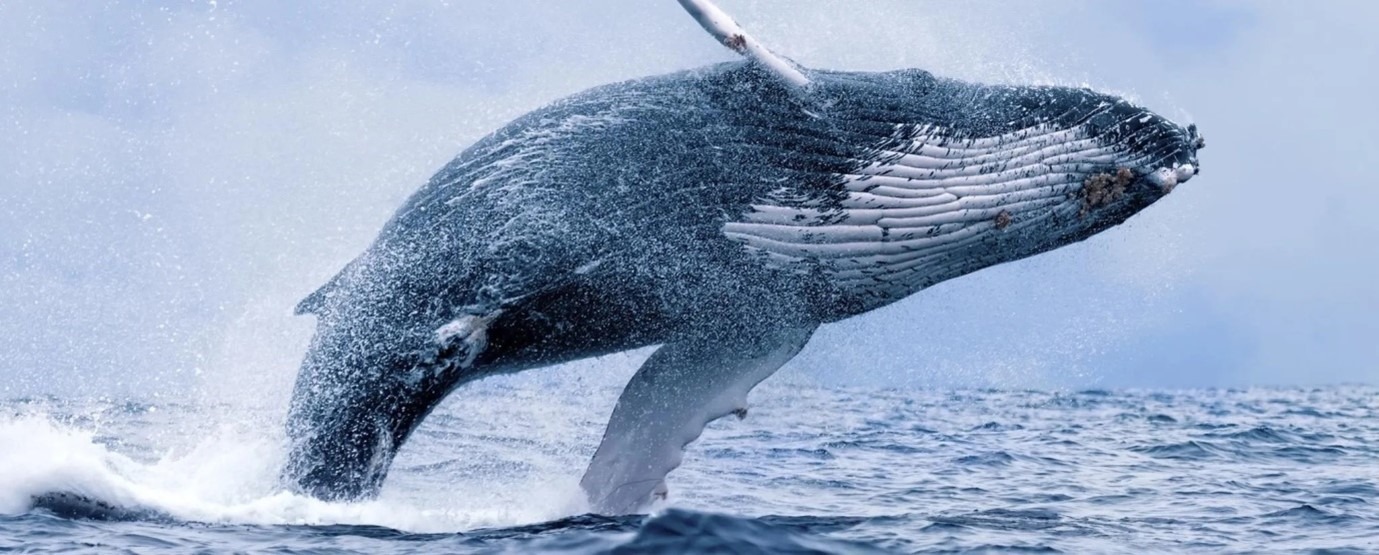
- The Humpback Whale is a large baleen whale renowned for its complex vocalizations and spectacular acrobatic displays. The Arabian Humpback Whale, a distinct subpopulation found in Indian waters, is genetically unique and the most isolated whale population in the world.
- Distribution:
- Globally distributed across oceans and seas. In India, the Arabian Sea hosts the rare Arabian humpback whales.
- Habitat:
- Migrates seasonally between tropical breeding grounds and temperate feeding grounds. Arabian humpbacks are non-migratory and breed off the Indian coast.
- Threats:
- Faces serious threats from oil and gas exploration, underwater noise pollution, ship strikes, entanglement in fishing nets, and habitat degradation due to coastal development.
- Conservation Note:
- Due to its isolated nature, the Arabian humpback population is of particular conservation concern.
Mammal – LC – Indian Flying Fox
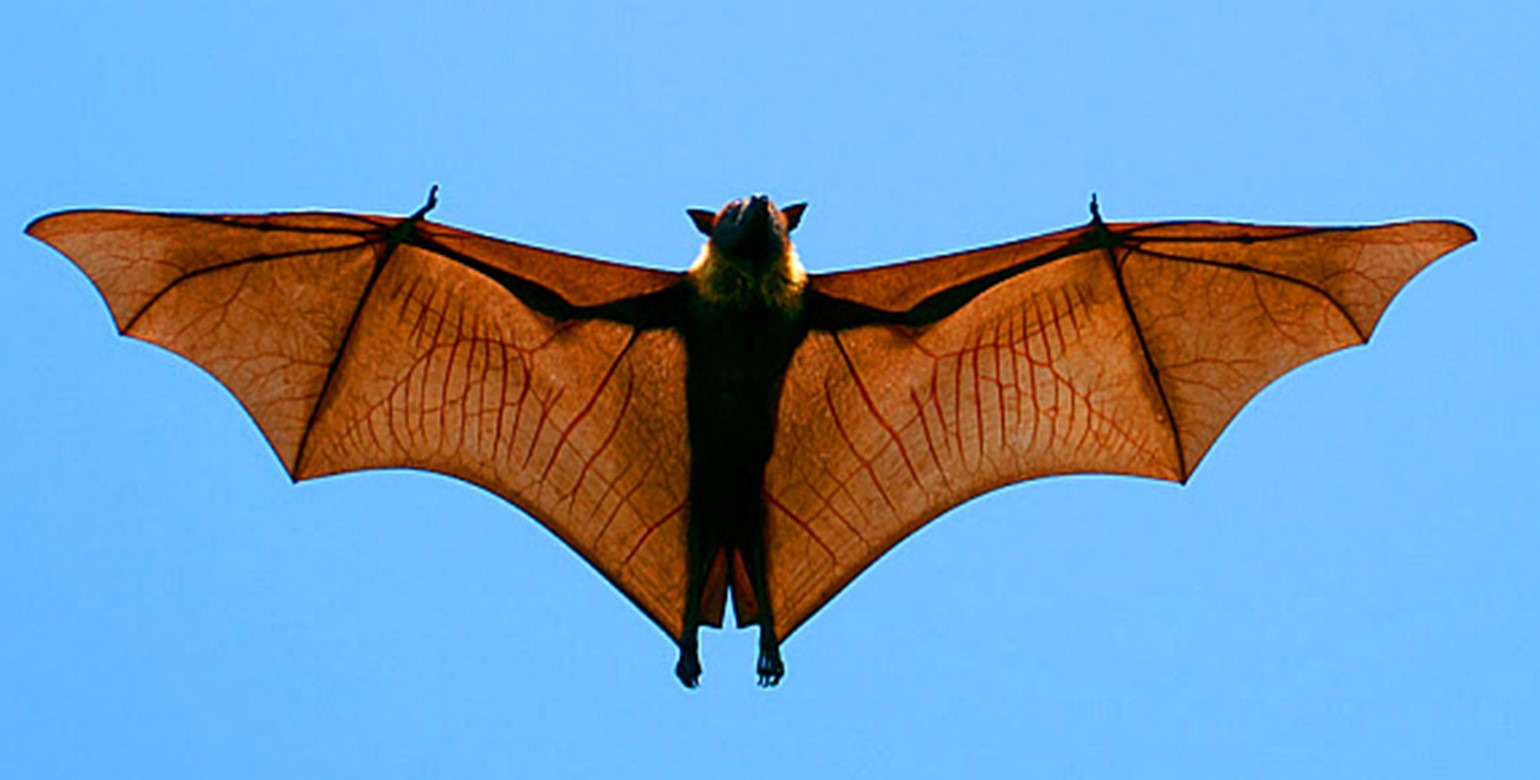
- The Indian Flying Fox, also known as the Greater Indian Fruit Bat, is the largest bat species in India and among the largest in the world. It belongs to the group of megabats and is entirely herbivorous, feeding primarily on ripe fruits, nectar, and flowers. These bats play an important ecological role as pollinators and seed dispersers, especially in forest ecosystems.
- Distribution:
- Native to the Indian subcontinent, the Indian flying fox is widely distributed across India, Sri Lanka, Bangladesh, Nepal, and parts of Pakistan. In India, it is found in both urban and rural settings, thriving in warm tropical climates.
- Habitat:
- Prefers roosting in large trees, especially banyan, peepal, or tamarind trees, often in large noisy colonies. They are commonly found in urban gardens, temple premises, parks, agricultural fields, riverbanks, and even roadside avenues. These bats choose sites with ample fruit availability and minimal disturbance.
- Ecological Importance:
- As nocturnal frugivores, they help in dispersing seeds and pollinating night-blooming plants, making them key players in maintaining biodiversity and forest regeneration.
- Threats:
- Despite being widespread, Indian flying foxes face increasing threats such as:
- Habitat destruction due to urbanization and tree felling.
- Electrocution from power lines and electric fencing.
- Hunting and persecution in some regions, either for bushmeat or due to misconceptions about disease transmission.
- Public Health Note:
- These bats are known natural reservoirs of certain zoonotic viruses, including the Nipah virus, which can be transmitted to humans under specific conditions. This has led to fear and conflict with local communities, often resulting in unnecessary culling despite their ecological importance.
Mammal – LC – Indian Fox
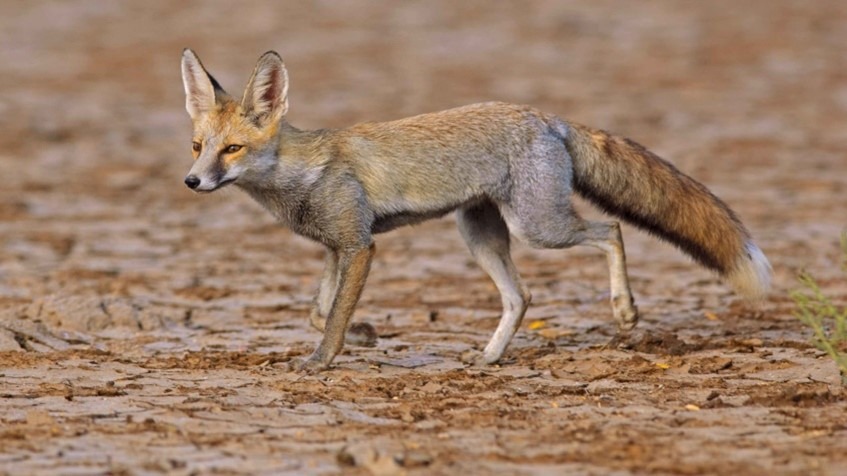
- The Indian fox, also known as the Bengal fox, is a small canid species endemic to the Indian subcontinent. It has a bushy, black-tipped tail and a delicate frame, adapted for swift movement across open landscapes.
- Distribution:
- Widely distributed across India, Nepal, and Pakistan, particularly in dry and semi-arid regions.
- Habitat:
- Prefers open grasslands, semi-arid scrublands, and gently undulating terrain. Avoids dense forests, mountainous areas, and deserts.
- Threats:
- Habitat degradation, disease transmission from domestic animals, and competition from invasive species.
- Conservation:
- IUCN Status: Least Concern
- CITES: Appendix III
- WPA (India): Schedule II
Mammal – LC – Indian Giant Flying Squirrel
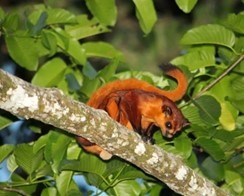
- The Indian giant flying squirrel, also known as the large brown flying squirrel, is a nocturnal and arboreal mammal known for its gliding ability, facilitated by a membrane called the patagium stretching between its limbs.
- Distribution:
- Found patchily in the Indian subcontinent, Sri Lanka, Bangladesh, and parts of SE Asia and China.
- Habitat:
- Deciduous and evergreen forests, plantations, and wooded hills, often nesting in tree cavities.
- Threats:
- Habitat loss due to deforestation, and fragmentation of forest corridors.
Mammal – LC – Nilgai
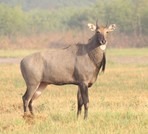
- The Nilgai, or Blue Bull, is the largest antelope species in Asia and is native to the Indian subcontinent. It is named for the bluish-gray coloration of adult males.
- Distribution:
- Widely found in India, particularly in Rajasthan, Gujarat, Madhya Pradesh, and Uttar Pradesh. Also occurs in parts of Nepal and Pakistan.
- Habitat:
- Inhabits grassy plains, dry deciduous forests, scrublands, and agricultural landscapes. Avoids dense forests and deserts.
- Conservation & Sightings:
- Commonly seen in protected areas like Ranthambhore NP, Pench TR, Keoladeo NP, and Indravati NP.
- Status:
- IUCN: Least Concern
- WPA (India): Schedule I
Mammal – LC – Indian Spotted Chevrotain
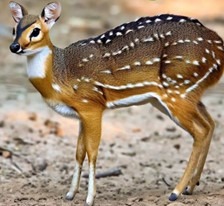
- The Indian spotted chevrotain, also known as the mouse deer, is a small, shy, and nocturnal ungulate endemic to India.
- Distribution:
- Found in southern and central India, especially in the Western and Eastern Ghats.
- Habitat:
- Inhabits moist deciduous and evergreen forests, plantations, and dense undergrowth near water sources.
- Conservation:
- IUCN: Least Concern
- CITES: Appendix III
- WPA: Schedule II
Mammal – LC – Indian Grey Mongoose
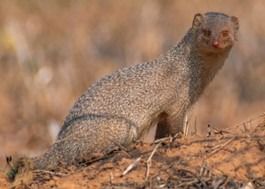
- The Indian grey mongoose is a small carnivore known for its agility and resistance to snake venom. It is the state animal of Chandigarh.
- Distribution:
- Native to the Indian subcontinent and parts of West Asia.
- Habitat:
- Found in scrublands, cultivated fields, open forests, and near human habitation.
- Threats:
- Habitat loss and hunting for the pet trade and traditional medicine.
Mammal – LC – Rhesus Monkey

- The Rhesus monkey is a diurnal, omnivorous primate known for its adaptability and widespread presence. It has been extensively used in medical research.
- Distribution:
- Widespread across South, Central, and Southeast Asia. In India, it is found throughout the northern and central regions, but is largely absent in Peninsular India.
- Habitat:
- Occupies a broad range of habitats from forests, grasslands, to urban areas. It is found in tundra, deserts, and city centers.
- Conservation:
- IUCN: Least Concern
- CITES: Appendix III
- WPA: Schedule I
Mammal – LC – Red Fox
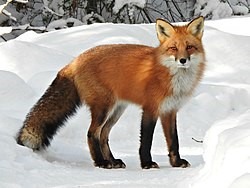
- The Red fox is the most widely distributed member of the Carnivora order. It is highly adaptable and is found in a variety of ecosystems.
- Distribution:
- Throughout the Northern Hemisphere including the high Himalayas in India.
- Habitat:
- From forests and grasslands to arid regions and high mountains.
- Threats:
- Habitat loss, hunting, and persecution due to its predatory habits.
Mammal – LC – Small Indian Civet
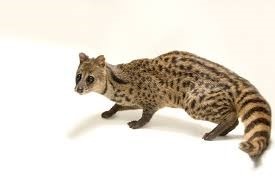
- The Small Indian civet is a nocturnal, cat-like carnivorous mammal native to South and Southeast Asia. Recognized by its short limbs, pointed snout, and striped tail, it is a solitary and elusive species.
- Distribution:
- Found across the Indian subcontinent, Sri Lanka, Myanmar, Thailand, and parts of Southeast Asia.
- Habitat:
- Occupies a wide variety of habitats, including tropical and subtropical forests, grasslands, shrublands, mangroves, plantations, and even areas close to human settlements.
- Ecological Role:
- Plays an important role in controlling rodent and insect populations and also aids in seed dispersal.
- Threats:
- Hunted for its civet musk, a scented substance once widely used in perfumes.
- Habitat destruction due to agricultural expansion and urbanization.
- Conservation Status:
- IUCN: Least Concern
- WPA (India): Schedule II
Mammal – LC – Tibetan Wild Ass (Kiang)
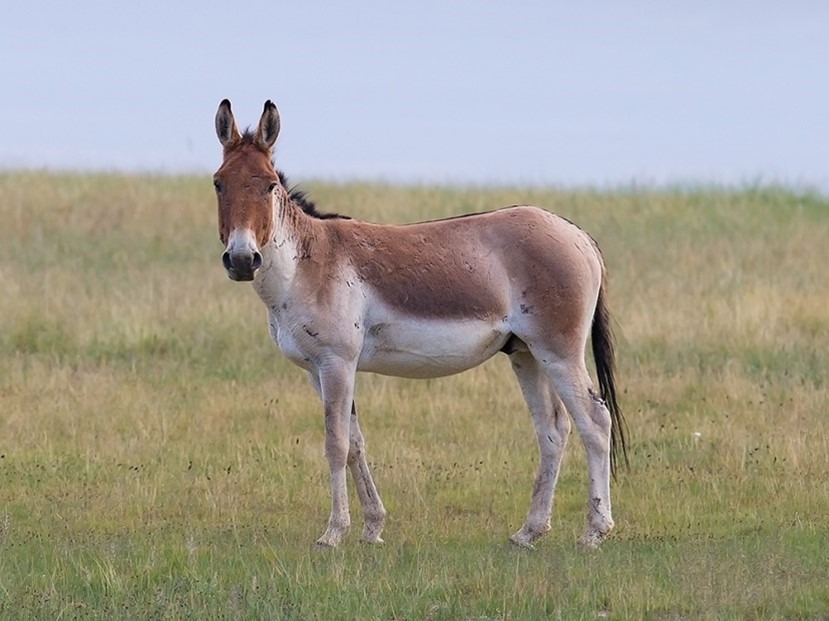
- The Tibetan wild ass, locally known as Kiang, is the largest of the wild ass species. It is a sturdy herbivore adapted to life on high-altitude plateaus and cold deserts.
- Distribution:
- Primarily found on the Tibetan Plateau. In India, it is restricted to the Changthang region of eastern Ladakh.
- Habitat:
- Inhabits cold desert plateaus, alpine meadows, and high-altitude grasslands above 4,000 meters. It thrives in dry open landscapes with sparse vegetation.
- Behavior:
- Lives in herds and feeds primarily on grasses, herbs, and shrubs. It is known for its swift running ability.
- Threats:
- Competition with domestic livestock for grazing resources.
- Habitat encroachment due to expanding pastoralism.
- Conservation Status:
- IUCN: Least Concern
- WPA (India): Schedule I
Mammal – LC – Travancore Flying Squirrel
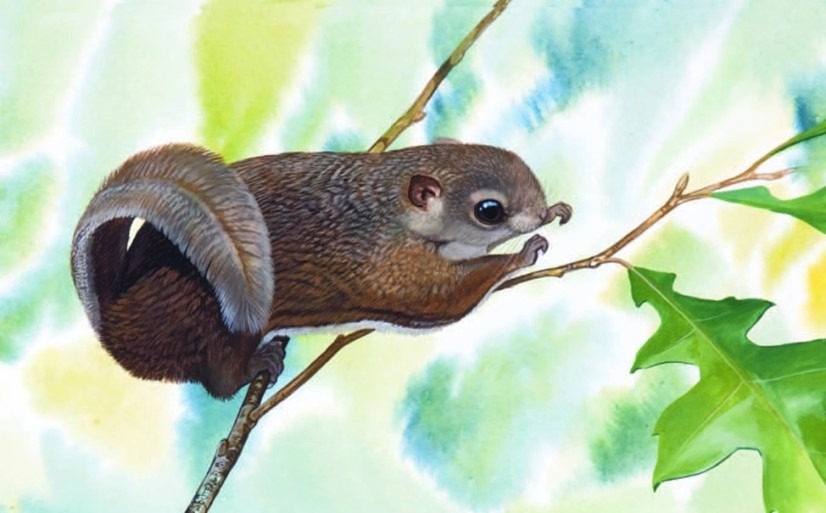
- The Travancore flying squirrel is a large, gliding nocturnal rodent endemic to the southern Western Ghats of India. It is known for its thick, reddish-brown fur and its ability to glide using a membrane called the patagium.
- Distribution:
- Endemic to the southern Western Ghats in Kerala and Tamil Nadu, including protected areas like Periyar and Silent Valley.
- Habitat:
- Inhabits tropical evergreen and semi-evergreen forests. Prefers tall trees with dense canopy cover, which facilitates gliding.
- Behavior:
- Solitary and nocturnal; uses tree cavities for nesting. Feeds on fruits, leaves, bark, and occasionally insects.
- Threats:
- Habitat fragmentation and deforestation.
- Human disturbance and degradation of forest cover.
- Conservation Status:
- IUCN: Least Concern
- WPA (India): Schedule II
Mammal – LC – Wild Boar
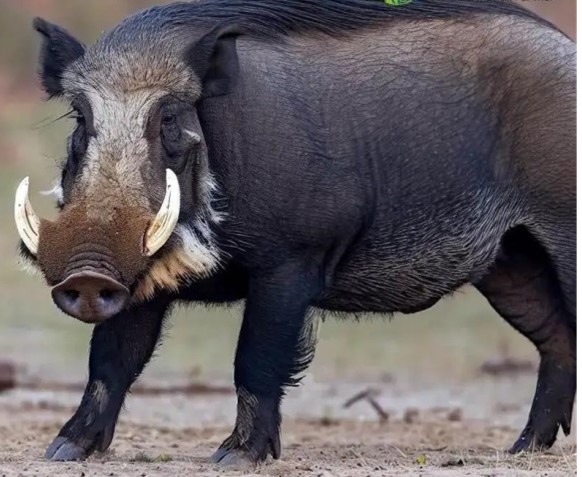
- The wild boar (Sus scrofa), also known as the wild pig, is a widespread species native to much of Eurasia and North Africa. It is the wild ancestor of the domestic pig and is highly adaptable to diverse environments.
- Distribution:
- Native to Europe, North Africa, and large parts of Asia, including most of India.
- Habitat:
- Occupies a wide range of habitats including forests, grasslands, scrublands, wetlands, and even agricultural lands. Often found near water sources.
- Behavior:
- Omnivorous, opportunistic feeder; forages on roots, tubers, fruits, small animals, and carrion. Known to raid farmlands, leading to conflict with farmers.
- Threats:
- Hunting (for meat and sport).
- Persecution due to crop damage.
- Habitat degradation.
- Conservation Status:
- IUCN: Least Concern
- WPA (India): Schedule III
Mammals – Miscellaneous
Mammal – Misc – Asiatic Wildcat
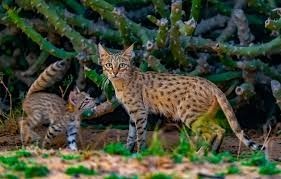
- The Asiatic wildcat, also known as the Indian desert cat or Asian steppe wildcat, is a subspecies of the African wildcat. It is well adapted to dry environments and resembles a domestic cat, but is larger and more robust.
- Distribution:
- Found across Central, South, and East Asia. In India, it is primarily distributed in arid and semi-arid regions of Gujarat, Rajasthan, Madhya Pradesh, and Maharashtra.
- Habitat:
- Inhabits scrub deserts, grasslands, and temperate forests, often in areas with minimal human presence.
- Behavior:
- Nocturnal and solitary; preys on small mammals, birds, and reptiles.
- Threats:
- Habitat destruction and fragmentation.
- Hybridization with domestic cats.
- Illegal pet trade and hunting.
- Conservation Status:
- IUCN: Not Evaluated as a subspecies
- CITES: Appendix II
Mammal – Misc – Black Panther

- The Black panther is not a separate species but a melanistic variant of the leopard (Panthera pardus) in Asia or jaguar (Panthera onca) in the Americas. In India, black panthers are melanistic leopards with excess black pigmentation, yet their rosettes remain visible in proper light.
- Distribution:
- Found in several parts of India, including the Western Ghats, central Indian forests, and parts of the Eastern Ghats.
- The Kabini Wildlife Sanctuary in Karnataka is particularly famous for regular sightings of the elusive black panther, often referred to as the “Ghost of Kabini”.
- Habitat:
- Dense tropical forests with thick vegetation, which provide the necessary cover for this elusive animal.
- Behavior:
- Solitary and highly elusive. Despite its dark coloration, it retains the same behavior and ecology as the typical leopard.
- Ecological Role:
- Top predator, plays a vital role in maintaining the ecological balance.
- Conservation Status:
- Protected under the same status as leopards:
- IUCN: Vulnerable (as Panthera pardus)
- WPA (India): Schedule I
- Protected under the same status as leopards:
Mammal – Misc – Himalayan Wolf
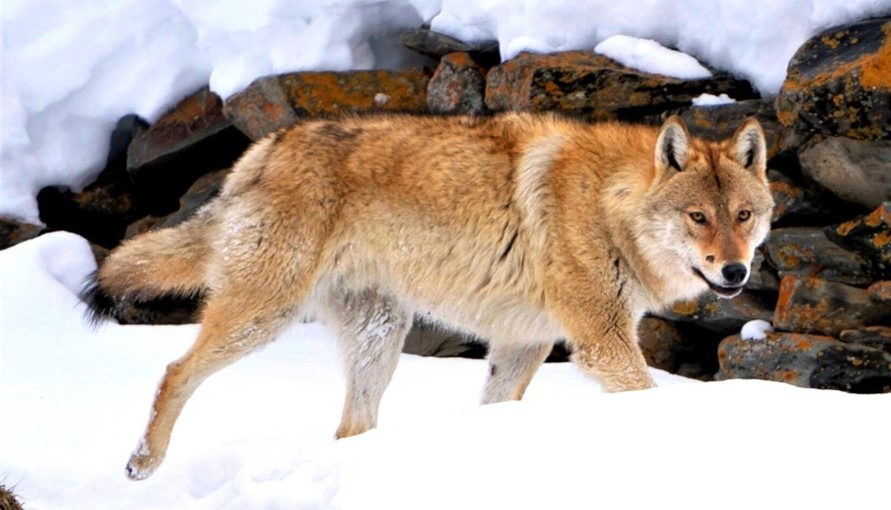
- The Himalayan wolf is a genetically distinct and ancient lineage of the gray wolf (Canis lupus), adapted to the cold, high-altitude ecosystems of the Himalayas. It is considered one of the most evolutionarily significant canids globally.
- Distribution:
- Found across the high-altitude regions of the Indian Himalayas, particularly in Ladakh, Himachal Pradesh, and Uttarakhand.
- Habitat:
- Cold, arid alpine and subalpine regions, high-altitude grasslands, and open steppes.
- Threats:
- Habitat fragmentation, retaliatory killings due to livestock predation, and limited legal protection.
- Conservation Note:
- It is not yet officially recognized as a separate species, which limits focused conservation action. However, genetic studies suggest it merits unique conservation status.
Mammal – Misc – Pangolin
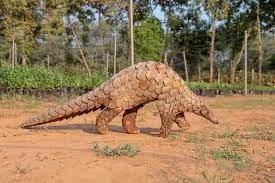
- India is home to two pangolin species, both highly threatened due to illegal wildlife trade.
🦔 Indian Pangolin (Manis crassicaudata) – Schedule I, IUCN: EN
- Large, heavily built, and covered in overlapping scales. It is terrestrial and primarily nocturnal.
- Distribution:
- Found widely across India, except in the high Himalayas and NE states.
- Habitat:
- Forests, grasslands, and agricultural lands.
- Burrowing behavior:
- Excellent digger, makes large burrows for shelter and breeding.
🦔 Chinese Pangolin (Manis pentadactyla) – Schedule I, IUCN: CR
- Smaller and more arboreal than Indian pangolin, with overlapping scales and a long, prehensile tail.
- Distribution:
- Found only in the northeastern states of India.
- Habitat:
- Prefers subtropical and tropical forests.
Key Differences:
Trait | Indian Pangolin | Chinese Pangolin |
Size | Larger | Smaller |
Habitat | Terrestrial | Arboreal & terrestrial |
Distribution | All over India | NE India only |
IUCN Status | Endangered | Critically Endangered |
Common Threat: Illegal trade for their scales and meat, used in traditional medicine and luxury cuisine.
Mammal – Misc – Pig-Tailed Macaque
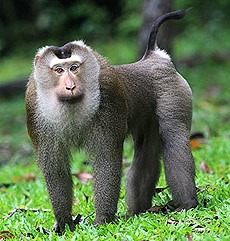
- Named for their short, pig-like tail, these monkeys are intelligent and sociable, forming troops of up to 100 individuals.
Northern Pig-tailed Macaque (Macaca leonina) – IUCN: VU
- Distribution:
- Found in NE India, south of the Brahmaputra River.
- Habitat:
- Moist and evergreen forests; also seen near human settlements and agricultural land.
- Distribution:
Southern Pig-tailed Macaque (Macaca nemestrina) – IUCN: EN
- Distribution:
- Very rare in India; primarily found in the southern parts of Southeast Asia. Occasional reports in extreme NE India.
- Habitat:
- Dense tropical forests with high humidity and canopy cover.
- Threats:
- Habitat loss due to deforestation, hunting for meat and pet trade, and conflicts with humans.
- Distribution:
Mammal – Misc – Porcupine
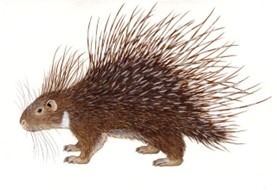
Indian Crested Porcupine (Hystrix indica) – IUCN: LC
- A large rodent with black and white quills and a distinctive crest along its back.
- Distribution:
- Widely found across the Indian subcontinent.
- Habitat:
- Found in forested areas, agricultural lands, and rocky terrains.
- Behavior:
- Nocturnal and herbivorous, feeding on roots, tubers, and crops.
Malayan Porcupine (Hystrix brachyura) – IUCN: LC
- Slightly smaller than Indian porcupine with shorter quills.
- Distribution:
- Found in NE India, extending into SE Asia.
- Habitat:
- Moist tropical forests and hills.
- Threats:
- Hunted for meat and traditional medicine; conflict with farmers due to crop damage.
Mammal – Misc – Sela Macaque (Macaca selai) – Newly Described Species
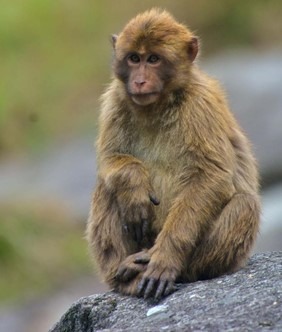
- The Sela Macaque is a recently discovered macaque species named after the Sela Pass in Arunachal Pradesh. It was earlier considered a subspecies of Arunachal macaque but has now been classified as a distinct species.
- Distribution:
- Found in the western and central Arunachal Pradesh region.
- Habitat:
- Temperate broadleaf and mixed forests, high-elevation mountainous terrain.
- Conservation Note:
- As a newly described species, its population status is not well known, but likely threatened due to limited range and habitat disturbance.
- Importance:
- Its discovery highlights the biodiversity richness and ecological uniqueness of Northeast India.
Birds Bottom of Form
Birds – Critically Endangered (CR)
The Critically Endangered category under the IUCN Red List includes species that face an extremely high risk of extinction in the immediate future. These birds are at the brink of survival due to rapid population declines, habitat destruction, hunting, and climate change. India, as a biodiversity-rich nation, is home to several bird species under this category. Their protection is vital not just for ecological balance but also for meeting India’s global conservation commitments under the Convention on Biological Diversity (CBD) and Sustainable Development Goals (SDGs).
✅ Nicobar Megapode (Megapodius nicobariensis)

- A unique mound-building bird found only in the Nicobar Islands. It uses
- geothermal heat for incubation.
- Threats: Habitat loss due to tsunamis, invasive species, and human disturbance.
Conservation Need: Strict protection of nesting sites and restriction on human activities.
✅ Baer’s Pochard (Aythya baeri)

- A diving duck once widespread across northeast India. Now reduced to a few sightings.
- Threats: Wetland degradation, hunting, and pollution.
- Conservation Need: Habitat restoration and protection of wintering sites.
✅ Bengal Florican (Houbaropsis bengalensis)
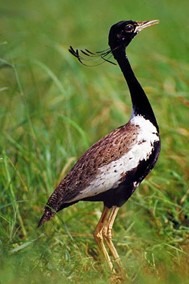
- A grassland bird found in the Terai region of Uttar Pradesh and Assam.
- Threats: Habitat conversion to agriculture, human settlement, and invasive weeds.
- Conservation Need: Protection of grasslands through eco-sensitive area management.
✅ Black-naped Pheasant Pigeon (Otidiphaps insularis)
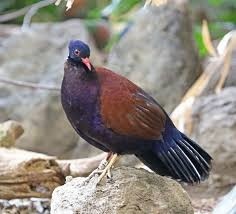
- Primarily native to Papua New Guinea, but relevant in conservation education about endangered pigeons.
- Relevance in Indian context: Highlights global extinction threats; used for comparative ornithological studies.
✅ Bugun Liocichla (Liocichla bugunorum)
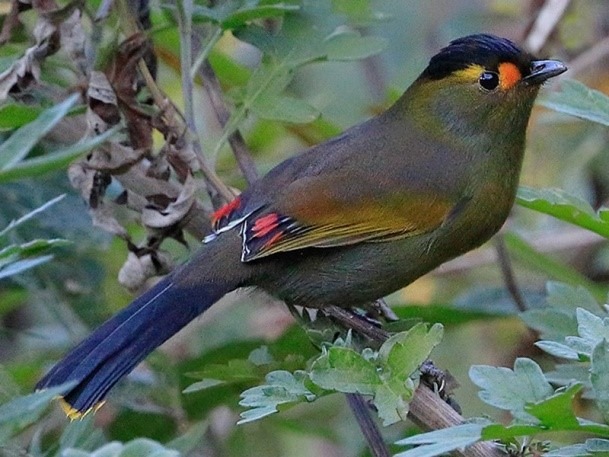
- A recently discovered bird, endemic to Arunachal Pradesh, known from just a few locations.
- Threats: Habitat disturbance and infrastructure development in its tiny range.
- Conservation Need: Community-led conservation in the Eaglenest Wildlife Sanctuary.
✅ Great Indian Bustard (Ardeotis nigriceps)
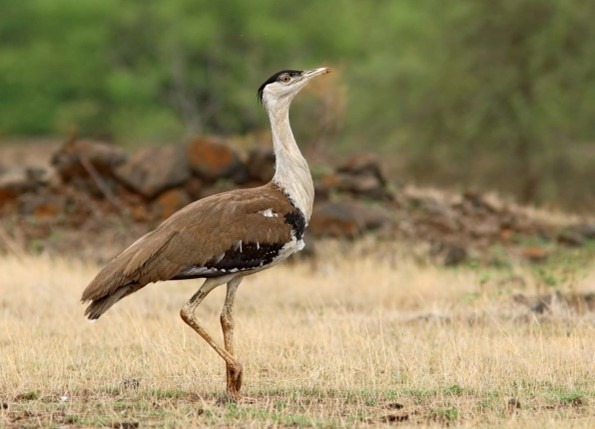
- Once found across western and central India, now restricted mainly to Rajasthan.
- Threats: Collisions with power lines, poaching, and habitat fragmentation.
- Conservation Efforts: Project Great Indian Bustard; breeding centres in Rajasthan.
✅ Himalayan Quail (Ophrysia superciliosa)

- Not seen since the 19th century, endemic to Uttarakhand, possibly extinct.
- Threats: Habitat loss, hunting, and human encroachment.
- Conservation Concern: Considered a ‘Lazarus species’ – potentially rediscoverable.
✅ Jerdon’s Courser (Rhinoptilus bitorquatus)
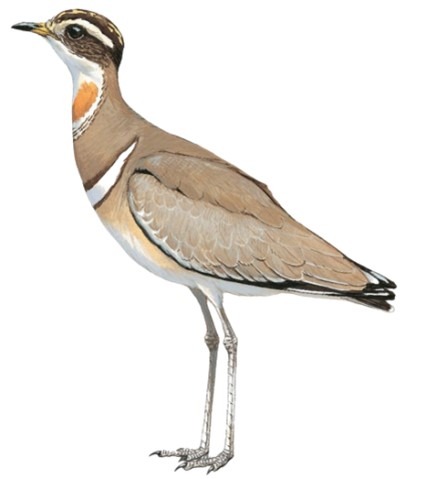
- A nocturnal bird endemic to Andhra Pradesh, rediscovered in 1986.
- Threats: Habitat degradation due to irrigation projects and agriculture.
- Conservation Actions: Monitoring and habitat management in the Sri Lankamalleswara Wildlife Sanctuary.
✅ Pink-headed Duck (Rhodonessa caryophyllacea)
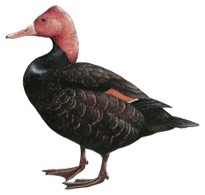
- Last confirmed sighting was in the 1950s; presumed extinct but occasional unconfirmed reports emerge.
- Threats: Wetland destruction and unregulated hunting.
- Significance: A symbol of extinction risk in wetland ecosystems.
✅ Siberian Crane (Leucogeranus leucogeranus)
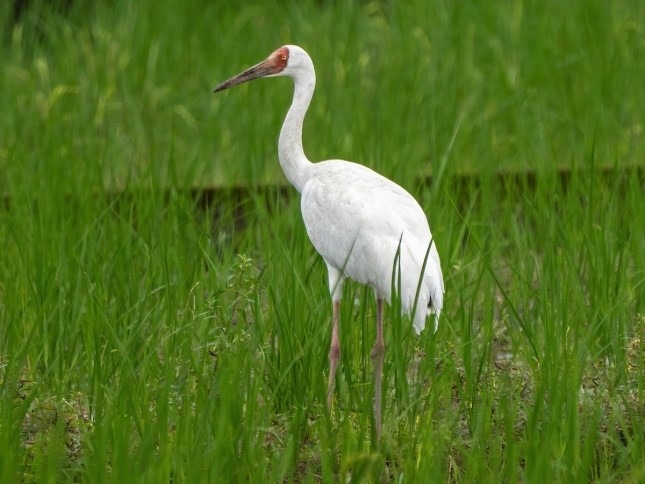
- A migratory bird once wintering at Keoladeo National Park, Rajasthan.
- Threats: Habitat loss in breeding and stopover sites, especially in Central Asia.
- Conservation Relevance: Under the CMS (Convention on Migratory Species) framework.
✅ Sociable Lapwing (Vanellus gregarius)

- Breeds in Central Asia, winters in parts of India, especially Rajasthan.
- Threats: Habitat degradation across migratory route, hunting in stopover countries.
- Conservation Priority: Transboundary cooperation for migratory bird protection.
✅ Spoon-billed Sandpiper (Calidris pygmaea)

- A tiny wader with a spoon-shaped bill, winters in parts of the Bay of Bengal.
- Threats: Loss of intertidal habitats and climate change.
- Conservation Strategy: International collaboration under the East Asian-Australasian Flyway Partnership (EAAFP).
✅ White-bellied Heron (Ardea insignis)
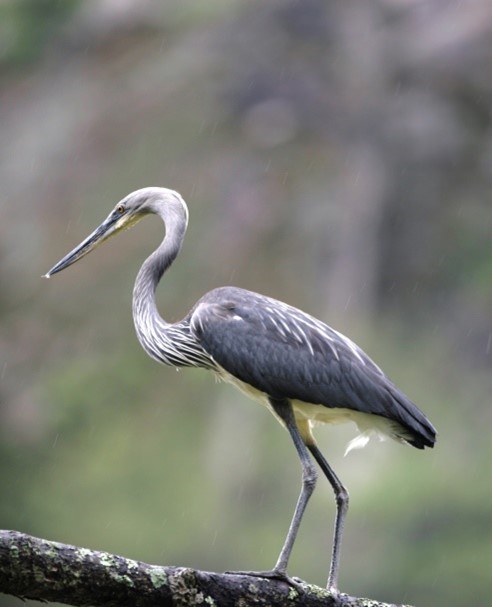
- One of the world’s rarest herons, found in the Eastern Himalayas—Arunachal Pradesh and Bhutan.
- Threats: Hydropower development, river pollution, and disturbance.
- Conservation Actions: Identification and protection of critical riverine habitats.
✅ Yellow-breasted Bunting (Emberiza aureola)
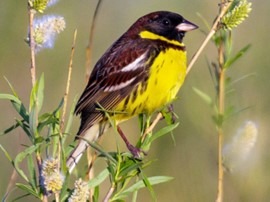
- A once-abundant migratory species that has declined due to mass hunting during migration.
- Threats: Hunting across its flyway, habitat loss in breeding grounds.
- Conservation Relevance: Highlighted under international flyway conservation efforts.
Birds – Endangered (EN)
Birds listed under the Endangered (EN) category of the IUCN Red List face a very high risk of extinction in the near future. These species have experienced significant population declines or exist in fragmented and rapidly shrinking habitats. Conservation of these species is crucial for maintaining ecological balance, wetland health, and the integrity of riverine and forest ecosystems. Here’s a closer look at some prominent endangered birds found in India:
✅ Black-bellied Tern (Sterna acuticauda)
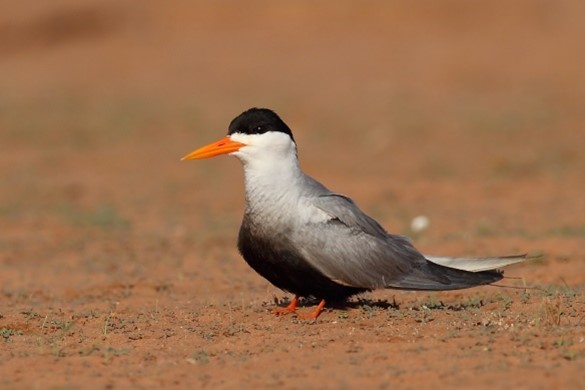
The Black-bellied Tern is a graceful riverine bird, notable for its slender body, black belly, and forked tail.
- Distribution: Found extensively across the Indian subcontinent, except in the Thar Desert and high-altitude Himalayan regions. Also occurs in parts of Southeast Asia.
- Habitat: Prefers large rivers, marshes, and adjoining floodplains, often seen skimming low over water.
- Threats: Pollution of rivers, sand mining, disturbance from boat traffic, and the spread of invasive species like water hyacinth.
- Conservation Status:
- IUCN: Endangered
- Urgency: Requires strict monitoring of riverine ecosystems and conservation of nesting sites on sandbanks.
✅ Forest Owlet (Heteroglaux blewitti)
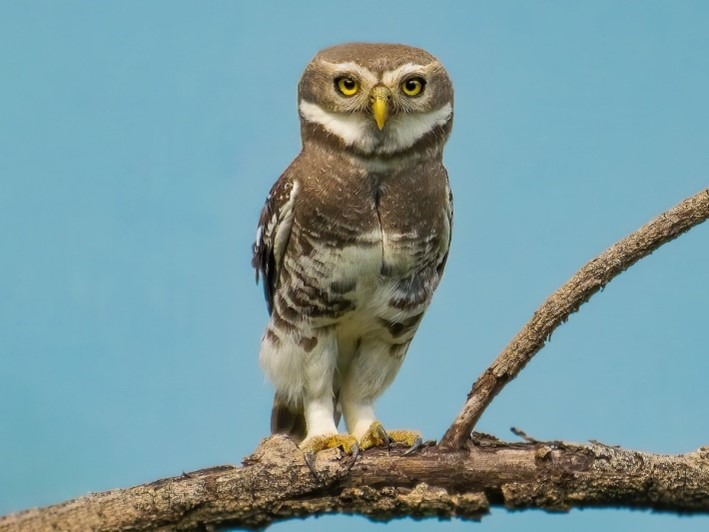
A critically rare and elusive bird, once believed to be extinct until its rediscovery in 1997.
- Endemism: Exclusively found in Central India, making it ecologically and conservationally significant.
- Distribution: Forested regions of Madhya Pradesh and Maharashtra, with a few records from Chhattisgarh.
- Habitat: Resides in dry deciduous forests, often with teak or bamboo undergrowth.
- Threats: Habitat destruction due to logging, forest fires, and human settlement expansion.
- Conservation Status:
- IUCN: Endangered
- CITES: Appendix I
- Wildlife Protection Act (WPA): Schedule I
- Conservation Efforts: Includes habitat preservation through protected areas and research monitoring.
✅ Indian Skimmer (Rynchops albicollis)
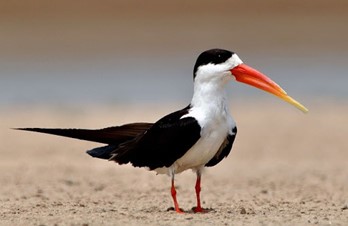
Also known as the Indian Scissors-bill, it is one of the three skimmer species globally and the only one found in South Asia.
- Distribution: Primarily seen along major river systems in the Indian subcontinent and parts of Indo-China.
- Habitat: Occupies large rivers, freshwater lakes, swamps, and coastal wetlands like estuaries.
- Unique Behavior: Recognized by its distinctive feeding technique of ‘skimming’ the water surface with its elongated lower mandible.
- Threats: Habitat fragmentation, unregulated sand mining, water pollution, and dam construction.
- Conservation Status:
- IUCN: Critically Endangered
- CITES: Appendix I
- CMS: Appendix II
- WPA: Schedule I
- Conservation Needs: Priority inclusion in riverine conservation plans and wetland restoration projects.
✅ Pallas’s Fish-Eagle (Haliaeetus leucoryphus)
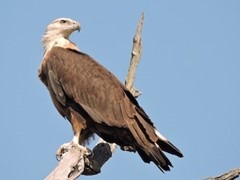
A large raptor with a strong preference for aquatic habitats, this eagle is often mistaken for other sea eagles.
- Other Names: Also called Pallas’s Sea Eagle or Band-tailed Fish Eagle.
- Distribution: Ranges across Central, East, South, and Southeast Asia. In India, strongholds exist in Assam, Uttarakhand, and parts of Northeast India.
- Habitat: Found near large lakes, wetlands, and rivers, where it feeds on fish and small mammals.
- Threats: Habitat encroachment, water pollution, decline in fish stocks, and electrocution from power lines.
- Conservation Status:
- IUCN: Endangered
- CITES: Appendix II
- CMS: Appendix I
- Conservation Actions: Focus on wetland conservation, awareness among local communities, and protection from infrastructure threats.
✅ Spotted Greenshank (Tringa guttifer)

Also known as Nordmann’s Greenshank, it is a migratory shorebird from the sandpiper family.
Distribution: Breeds in eastern Russia and migrates across East, South, and Southeast Asia during winter. In India, it is mainly recorded along the West Bengal and Odisha coasts.
- Habitat: Favors estuaries, mudflats, saltpans, rice fields, and coastal swamps.
- Threats: Coastal development, reclamation of wetlands, industrial waste, and human disturbance during migratory stopovers.
- Conservation Status:
- IUCN: Endangered
- CITES: Appendix I
- CMS: Appendix I
- Conservation Needs: International coordination under flyway conservation initiatives and protection of coastal habitats.
✅ Steppe Eagle (Aquila nipalensis)

A majestic bird of prey known for its well-feathered legs, hence the nickname “Booted Eagle.”
Distribution: Widespread across Central Asia, migrating to South Asia, Arabian Peninsula, and Africa during winter. In India, seen in open dry habitats, especially in Gujarat, Rajasthan, and Haryana.
Habitat: Prefers open steppes, semi-deserts, and mountainous areas; often perches on electricity poles.
Threats: Collision with power infrastructure, loss of open habitats, and poisoning from carcasses.
Conservation Status:
IUCN: Endangered
CITES: Appendix II
CMS: Appendix I
Conservation Efforts: Includes powerline insulation projects and monitoring migratory routes.
Birds – Vulnerable (VU)
Birds under the Vulnerable (VU) category of the IUCN Red List face a high risk of extinction in the medium-term future if current trends continue. Many of these birds have undergone moderate population declines due to habitat loss, hunting, pollution, or climate change. Here’s a detailed overview of notable VU bird species in India:
✅ Common Pochard (Aythya ferina)
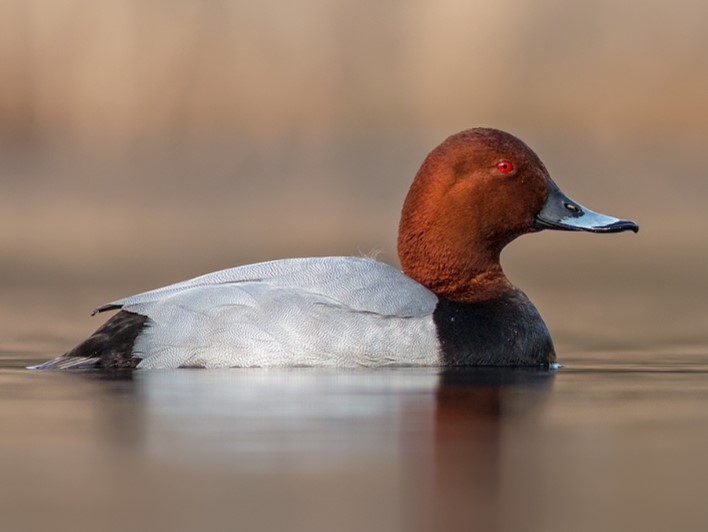
A medium-sized diving duck, the Common Pochard is frequently observed in winter months across northern India.
- Distribution: Widespread across northern and central India, though largely absent from southern India beyond the Central Deccan Plateau.
- Habitat: Prefers marshes, swamps, slow-moving rivers, and freshwater lakes with rich vegetation.
- Threats: Hunting (for sport and food), habitat degradation due to tourism, invasive species, and avian diseases like avian influenza.
- IUCN: Vulnerable
- Conservation Note: Highlights the vulnerability of migratory waterfowl to both habitat and global climatic pressures.
✅ Great Indian Hornbill (Buceros bicornis)
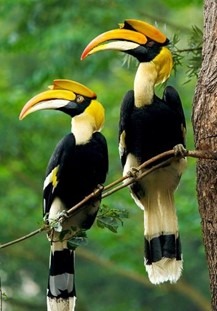
One of the most iconic forest birds, the Great Indian Hornbill is known for its massive yellow casque and unique nesting behavior.
- State Bird: Recognized as the State Bird of Arunachal Pradesh and Kerala.
- Distribution: Found in Northeast India and the Western Ghats; also occurs in parts of Southeast Asia and southern China.
- Habitat: Dense tropical evergreen and moist deciduous forests.
- Threats: Logging, deforestation, hunting for casques and feathers, and low reproductive rate.
- Conservation Status:
- IUCN: Vulnerable
- CITES: Appendix I
- WPA: Schedule I
- Ecological Role: Key seed disperser in forest ecosystems.
✅ Greater Spotted Eagle (Clanga clanga)
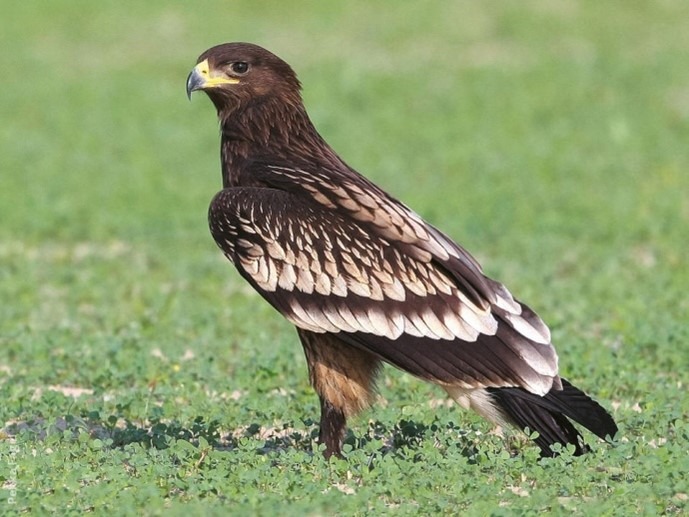
A large migratory eagle, often seen wintering in India. It is sometimes confused with the Steppe Eagle.
- Also Known As: A type of “Booted Eagle” due to its feathered legs.
- Distribution: Breeds in Eastern and Central Europe, and winters in the Indian subcontinent.
- Habitat: Lowland forests near wetlands; nests in tall trees or old raptor nests.
- Threats: Drainage of wetlands, agricultural expansion, and powerline collisions.
- Conservation Status:
- IUCN: Vulnerable
- CITES: Appendix II
- CMS: Appendix I
✅ Lesser Adjutant (Leptoptilos javanicus)
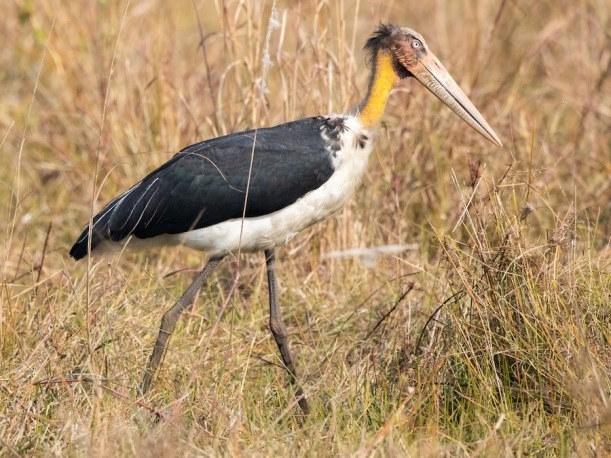
A large stork species, more solitary compared to the closely related Greater Adjutant.
- Distribution: Occurs in Northeast India, Himalayan foothills, and Gangetic plains.
- Habitat: Favors lakes, riverbanks, paddy fields, and other wetlands.
- Threats: Habitat degradation, wetland reclamation, hunting, and pollution.
- IUCN: Vulnerable
- Ecological Role: Important scavenger in wetland ecosystems.
✅ Narcondam Hornbill (Rhyticeros narcondami)
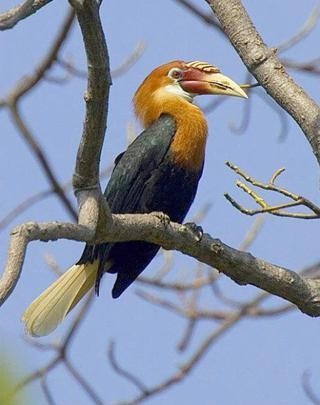
A rare, island-endemic hornbill, found only on the volcanic Narcondam Island in the Andaman & Nicobar Islands.
- Endemism: Restricted solely to Narcondam Island, making it highly vulnerable to habitat changes.
- Habitat: Mixed moist forests on hilly, volcanic terrain.
- Threats: Habitat disturbance, small population size, and introduction of invasive species.
- Conservation Status:
- IUCN: Vulnerable
- CITES: Appendix II
- WPA: Schedule I
- Conservation Needs: Stringent protection of the island habitat and prevention of species introduction.
✅ River Tern (Sterna aurantia)
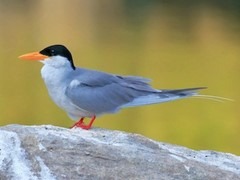
A slender, fork-tailed water bird found in freshwater habitats across Asia.
- Distribution: Seen along inland rivers in Iran, Afghanistan, the Indian subcontinent, and Southeast Asia.
- Habitat: Freshwater rivers, lakes, and occasionally estuaries.
- Threats: Hunting, pollution, damming of rivers, and nesting disturbances.
- IUCN: Vulnerable
- Note: The river tern is considered an indicator of riverine health and clean water ecosystems.
✅ Sarus Crane (Grus antigone)
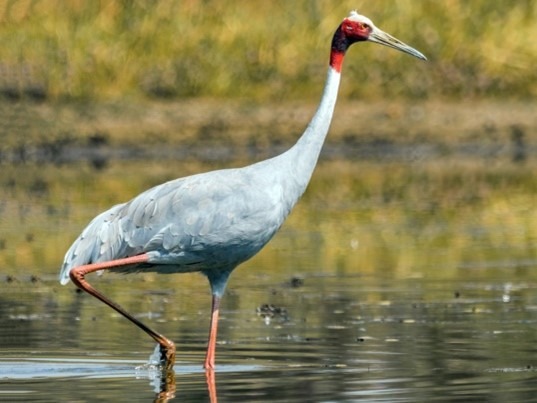
The tallest flying bird in the world, often seen in pairs with a deep red neck and head.
- Height: Stands around 4 feet tall.
- Distribution: Found in India, Southeast Asia, and parts of Australia. In India, it is common in Uttar Pradesh, Madhya Pradesh, and Gujarat, but absent in the Thar Desert.
- Habitat: Open wetlands, grasslands, and paddy fields.
- Threats: Wetland drainage, pesticide use, collision with powerlines.
- Conservation Status:
- IUCN: Vulnerable
- CITES: Appendix II
- Ecological Importance: Serves as an umbrella species for wetland conservation.
✅ Swamp Francolin (Ortygornis gularis)
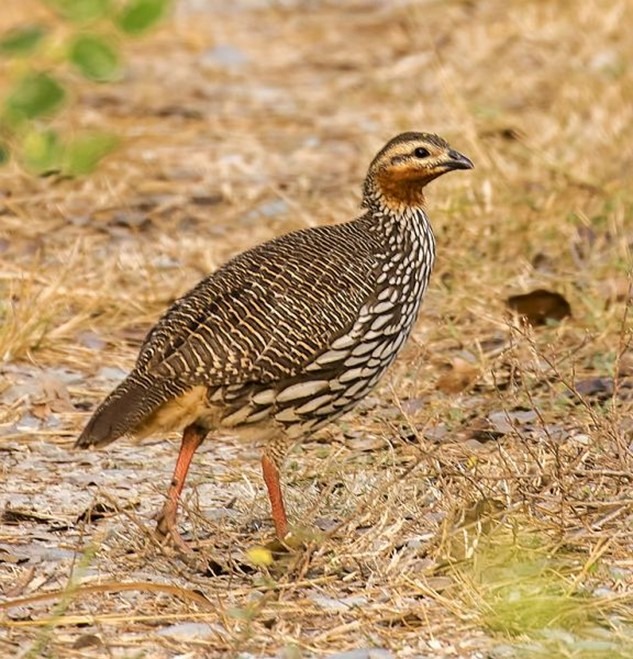
Also known as the Swamp Partridge, this bird is ground-dwelling and secretive.
- Distribution: Restricted to the foothills of the Himalayas, including parts of Bihar, UP, and Assam.
- Habitat: Prefers grasslands, sugarcane fields, and marshy agricultural lands.
- Threats: Habitat loss, flooding, and changes in land use.
- IUCN: Vulnerable
- Conservation Priority: Habitat restoration and wetland connectivity in the Gangetic plains.
✅ Yellow-throated Bulbul (Pycnonotus xantholaemus)
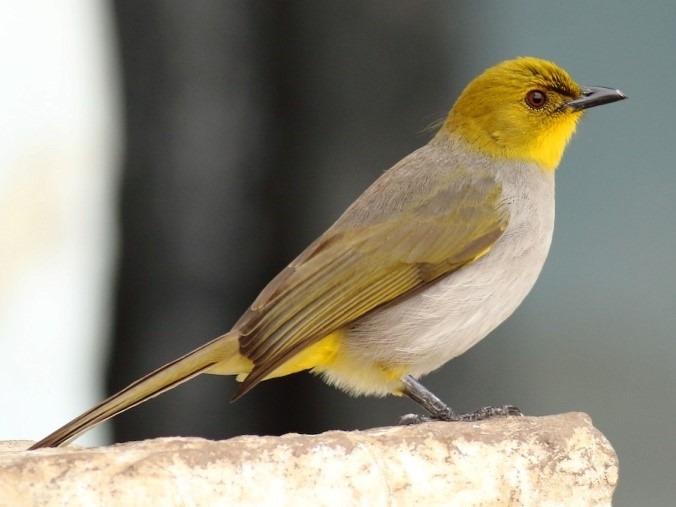
A rare songbird found only in certain parts of peninsular India.
Endemism: Restricted to the rocky hills and scrublands of the Deccan Plateau.
- Habitat: Inhabits dry deciduous forests, thorny scrub, and rocky areas with seasonal vegetation.
- Threats: Quarrying, mining, tourism pressure, and urban expansion.
- Conservation Status:
- IUCN: Vulnerable
- WPA: Schedule IV
- Conservation Suggestions: Site-specific monitoring and control of quarry operations.
Birds – Near Threatened (NT)
Birds listed under the Near Threatened (NT) category by the IUCN Red List are not currently endangered but are likely to qualify for a threatened category in the near future if the factors causing decline are not addressed. This list includes species that are essential indicators of environmental change and conservation priorities.
✅ Black-Necked Crane (Grus nigricollis)
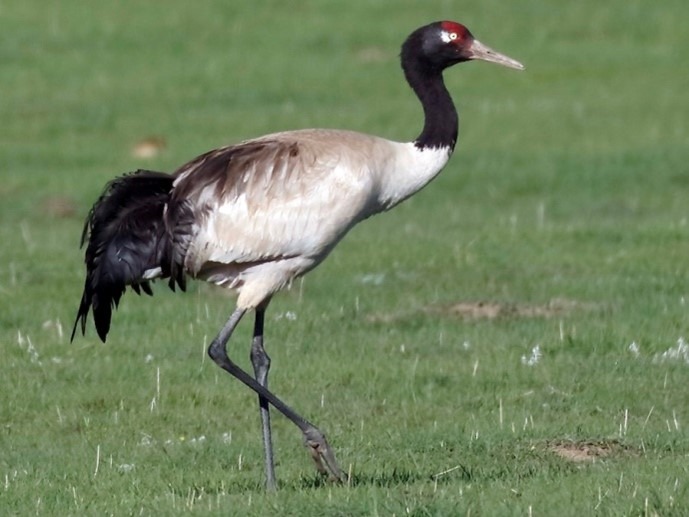
The Black-necked Crane is a revered species in Himalayan culture and plays a crucial ecological and cultural role.
- State Bird: Declared the State Bird of the Union Territory of Ladakh. (Previously of J&K)
- Distribution: Breeds in Ladakh, Tibet, and Sichuan (China); migrates during winter to Arunachal Pradesh and Bhutan.
- Habitat: High-altitude inland wetlands, especially in river valleys and grasslands near glacial lakes.
- Threats: Disturbance at breeding sites, wetland degradation, infrastructure development in high-altitude regions.
- Conservation Status:
- IUCN: Near Threatened
- CITES: Appendix I
- CMS: Appendix I
- WPA: Schedule I
✅ Mrs. Hume’s Pheasant (Syrmaticus humiae)
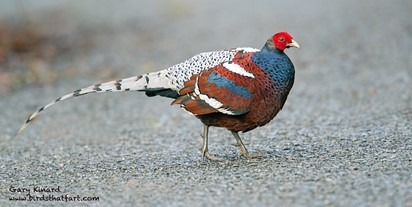
Also called Hume’s Bar-tailed Pheasant, this bird is a terrestrial beauty and cultural emblem.
- 🏅 State Bird: Manipur and Mizoram; locally known as “Nongin” in Manipuri and revered in tribal folklore.
- Distribution: Found in Northeast India, Myanmar, China, and Thailand.
- Habitat: Prefers tropical and sub-tropical forests, bamboo thickets, and scrub-covered hillsides.
- Threats: Deforestation, hunting, forest fires, and habitat fragmentation.
- Conservation Status:
- IUCN: Near Threatened
- CITES: Appendix I
- WPA: Schedule I
✅ Oriental Darter (Anhinga melanogaster)
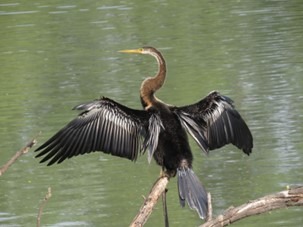
Also known as the Snakebird due to its long, slender neck which remains above water while diving.
- Distribution: Found across India, except in high-altitude Himalayan regions; most common in Assam and Eastern wetlands.
- Habitat: Prefers shallow inland wetlands, rivers, lakes, and swamps rich in fish.
- Threats: Pollution, fishing net entanglement, water diversion projects, and wetland loss.
- Conservation Status:
- IUCN: Near Threatened
- WPA: Schedule IV
✅ Oriental White Ibis (Threskiornis melanocephalus)
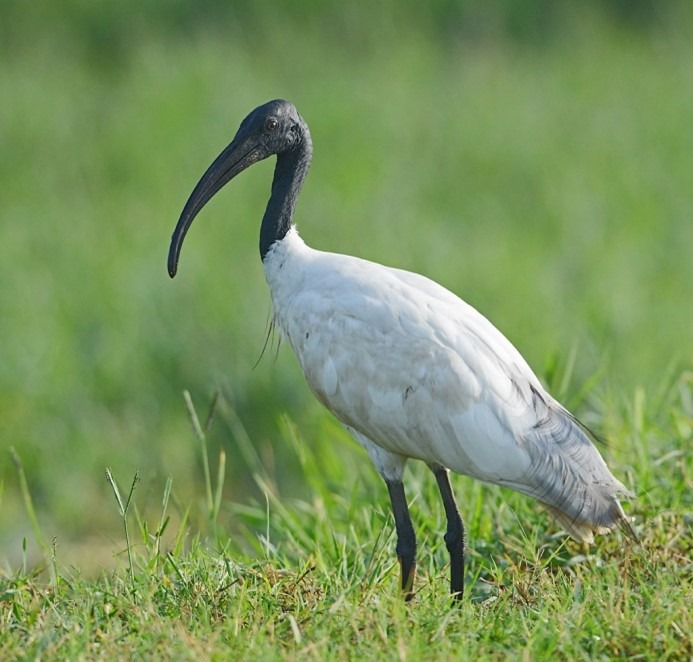
Also called Indian White Ibis, Black-headed Ibis, or Black-necked Ibis.
- Distribution: Across the Indian subcontinent and parts of Southeast Asia. In India, more common in western and central regions.
- Habitat: Freshwater marshes, paddy fields, riverbanks, mangroves, and even urban wetlands.
- Threats: Drainage of wetlands, pollution, plastic ingestion, and pesticide contamination.
- Conservation Status:
- IUCN: Near Threatened
- WPA: Schedule IV
✅ Painted Stork (Mycteria leucocephala)
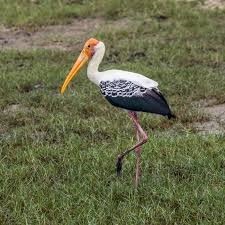
A large, distinctive wading bird with pink tertial feathers and yellow bill.
- Distribution: Found across Indian river plains and Southeast Asia.
- Habitat: Flooded plains, freshwater marshes, tanks, riverbanks, and sometimes rice fields.
- Threats: Wetland pollution, nest disturbance, habitat encroachment, and illegal trade.
- IUCN: Near Threatened
✅ Spot-Billed Pelican (Pelecanus philippensis)
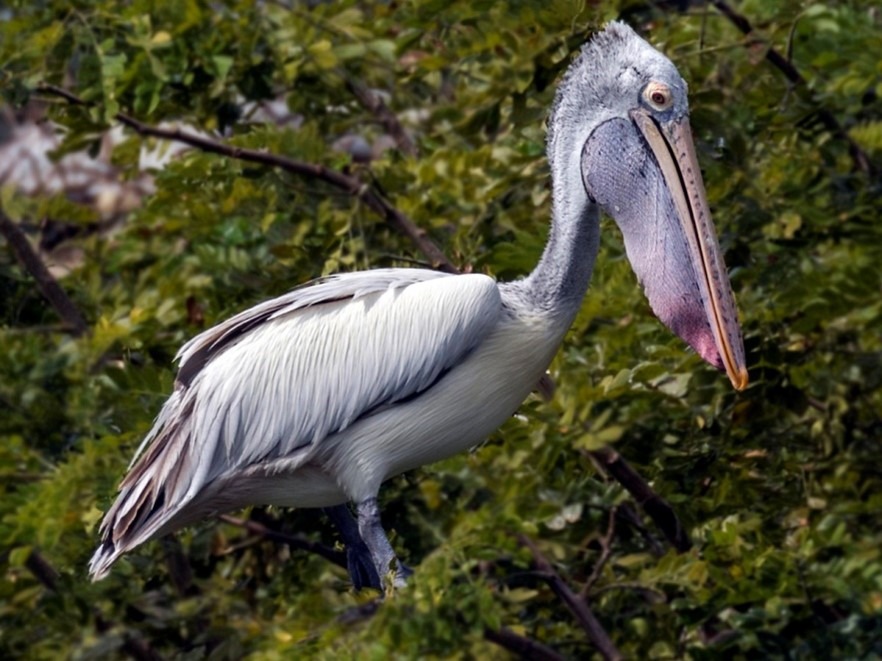
A large pelican species notable for the dark spots on its upper mandible.
- Also Called: Grey Pelican
- Distribution: Found in southern and northeastern India, including Terai region, and extends to Southeast Asia.
- Habitat: Inhabits both freshwater and brackish wetlands; nests colonially on tall trees like Acacia or palms.
- Threats: Nesting site loss, water pollution, fish scarcity, and encroachment of wetlands.
- Conservation Status:
- IUCN: Near Threatened
- WPA: Schedule IV
✅ White-Eyed Pochard (Aythya nyroca)
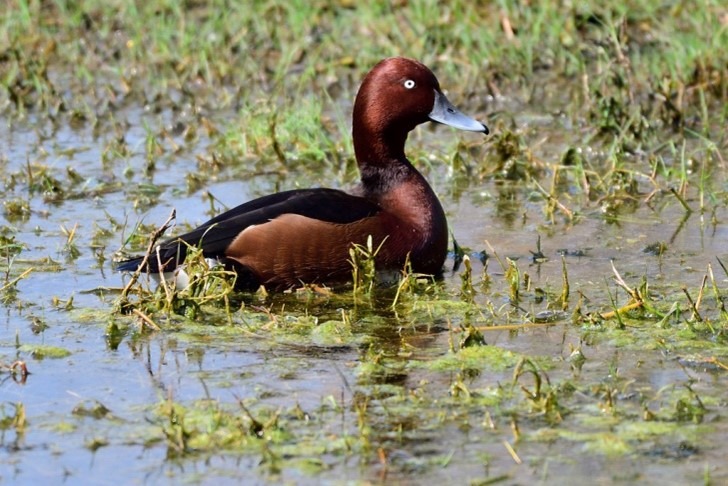
A medium-sized diving duck with a prominent white eye (in males).
- Distribution: Found across Europe, Central and South Asia, and parts of Southeast Asia. In India, mostly winter migrant but breeds in some parts.
- Habitat: Prefers freshwater wetlands with abundant vegetation. Rarely found in fast-flowing rivers.
- Threats: Habitat loss, unregulated tourism, shooting, and pollution.
- Conservation Status:
- IUCN: Near Threatened
Birds – Least Concern (LC)
Although classified as Least Concern by the IUCN Red List, these birds are still important for monitoring habitat health and ecosystem stability. Many are regionally endemic or face local threats despite a globally secure status.
✅ Amur Falcon (Falco amurensis)
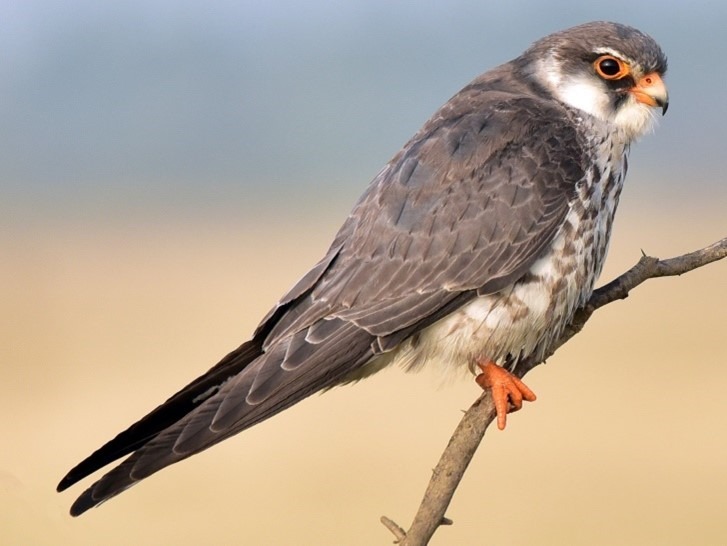
- World’s longest-distance migrating raptor.
- Nagaland is called the “Falcon Capital of the World“.
- Distribution: Breeds in East Asia; migrates across South and Southeast Asia to Eastern and Southern Africa.
- Habitat: Open woodlands, marshes, and agricultural fields.
- Threats: Illegal hunting during migration, especially in Northeast India (now reduced due to local conservation efforts).
- Conservation Status:
- IUCN: LC
- CITES: Appendix II
- CMS: Appendix II
- WPA: Schedule IV
✅ Bar-Headed Goose (Anser indicus)

- 🛫 Among the highest-flying birds in the world (over Himalayas).
- Distribution: Breeds in Central Asia; winters in South Asia, including Peninsular India and Northeast.
- Habitat: High-altitude lakes (breeding) and cultivated fields (wintering).
- Conservation Status:
- IUCN: LC
- WPA: Schedule IV
✅ Black-and-Orange Flycatcher (Ficedula nigrorufa)
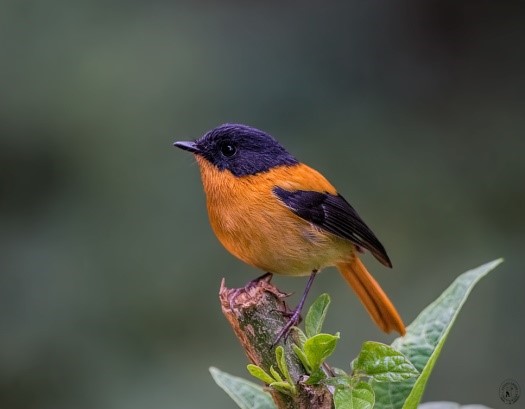
- A small, vividly colored endemic flycatcher.
- Distribution: Restricted to Western Ghats – Nilgiris, Palni Hills, Annamalai Hills.
- Habitat: Shola forests and moist ravines.
- Conservation Status:
- IUCN: LC
- WPA: Schedule IV
✅ Common Hill Myna (Gracula religiosa)
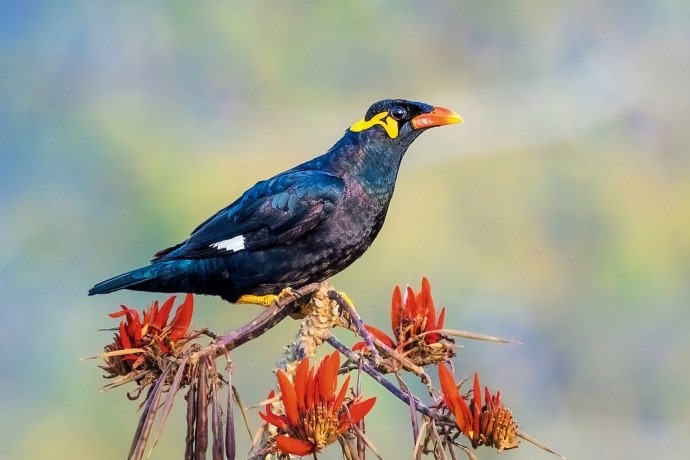
- Known for its mimicry; also called Bastar Hill Myna.
- 🏅 State Bird: Chhattisgarh; conserved in Kanger Valley NP.
- Distribution: Eastern India and mainland Southeast Asia.
- Habitat: Wet evergreen and moist deciduous forests.
- Threats: Illegal capture for pet trade.
- Conservation Status:
- IUCN: LC
- CITES: Appendix II
- WPA: Schedule I
✅ Edible-Nest Swiftlet (Aerodramus fuciphagus)
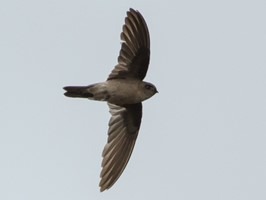
- Builds nests from saliva, harvested for bird’s nest soup.
- Distribution: Andaman Islands (India); widespread in Southeast Asia.
- Habitat: Limestone caves in coastal forests.
- Conservation Status:
- IUCN: LC
- WPA: Schedule I
✅ Greater Flamingo (Phoenicopterus roseus)
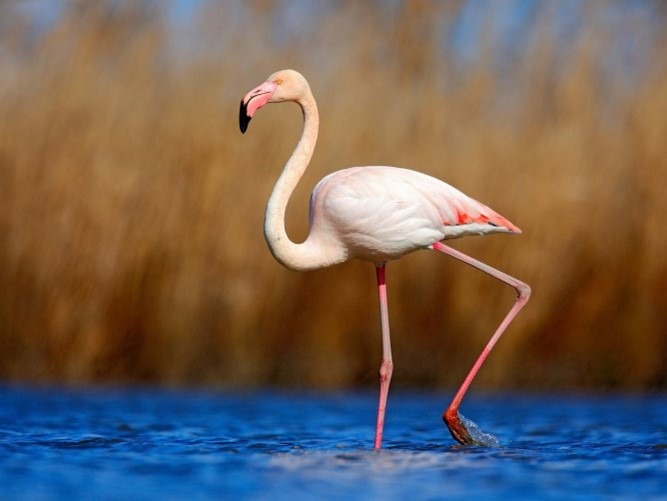
- The largest and most widespread flamingo species.
- 🏅 State Bird: Gujarat – seen in Nal Sarovar, Khijadiya, Thol, and Flamingo City.
- Distribution: Africa, Middle East, Indian subcontinent, and Europe.
- Habitat: Saline wetlands, saltpans, and alkaline lakes.
- Conservation Status:
- IUCN: LC
- CITES: Appendix II
- WPA: Schedule IV
✅ Grey Heron (Ardea cinerea)
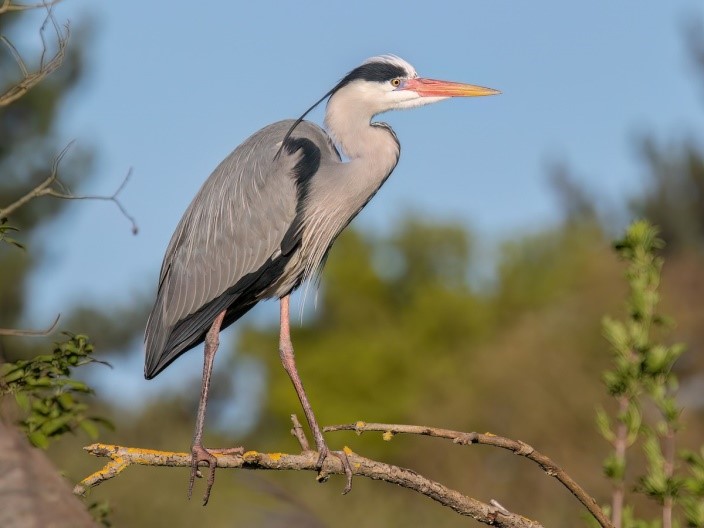
- A tall wading bird known for its still hunting technique.
- Distribution: Found throughout India, barring Thar Desert and high Himalayas.
- Habitat: Freshwater lakes, rivers, and marshlands.
- Conservation Status:
- IUCN: LC
- WPA: Schedule IV
✅ Himalayan Bulbul (Pycnonotus leucogenys)
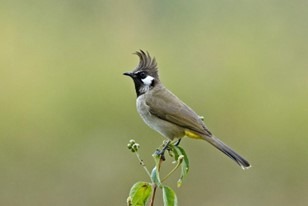
- Also known as White-cheeked or White-eared Bulbul.
- Distribution: Endemic to the Himalayan foothills.
- Habitat: Forest edges, gardens, agricultural areas.
- Conservation Status:
- IUCN: LC
- WPA: Schedule IV
✅ Little Egret (Egretta garzetta)
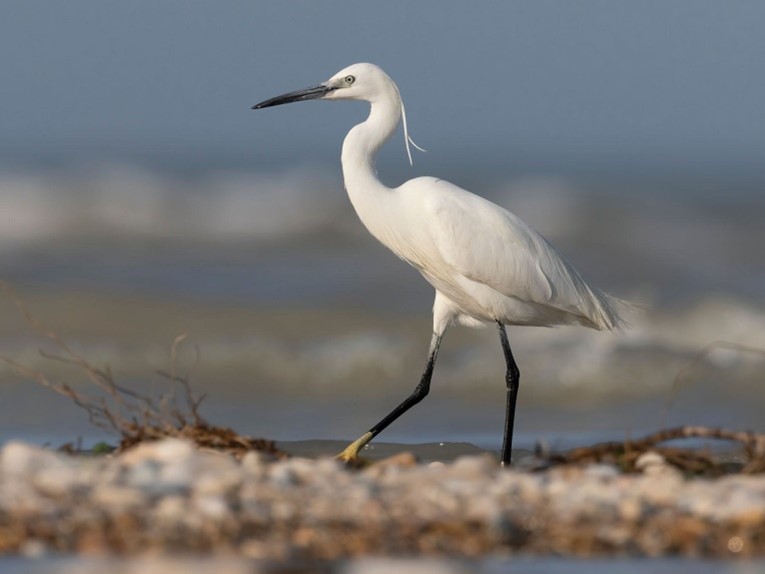
- A small, migratory aquatic bird with white plumage and black legs.
- Distribution: Widespread across Europe, Africa, Asia, and Australia.
- Habitat: Freshwater and brackish wetlands, rice paddies.
- Threats: Wetland degradation.
- Conservation Status:
- IUCN: LC
✅ Nilgiri Flycatcher (Eumyias albicaudatus)
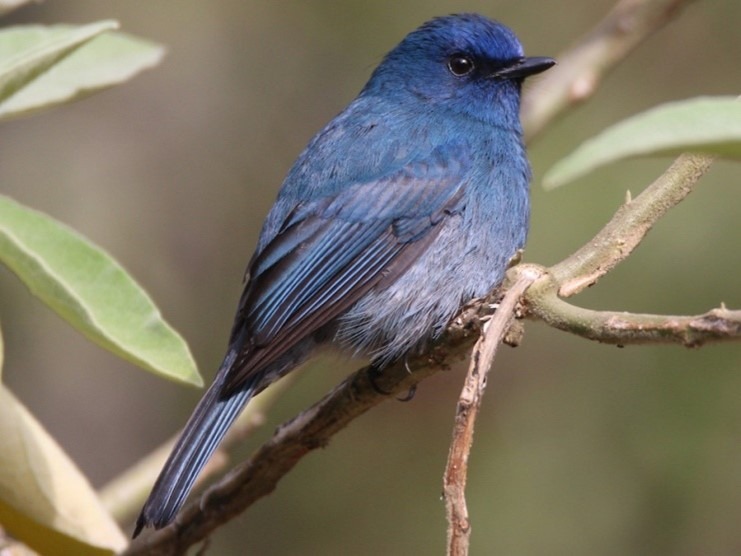
- A small, insectivorous bird with striking indigo-blue plumage (in males).
- Distribution: Endemic to the Western Ghats.
- Habitat: Evergreen hill forests and shola patches.
- Conservation Status:
- IUCN: LC
- WPA: Schedule IV
✅ Snow Partridge (Lerwa lerwa)
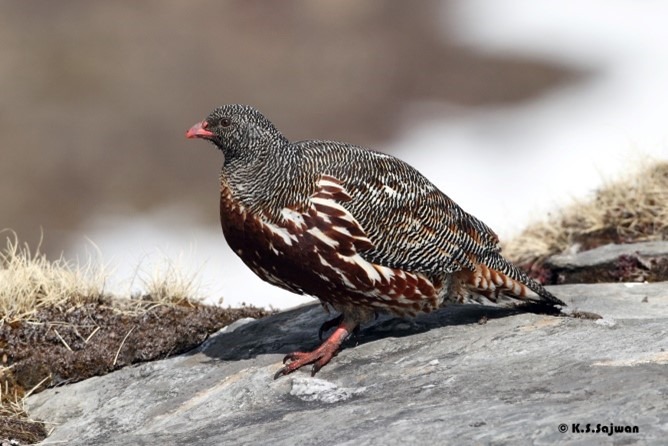
- A hardy ground-dwelling bird of cold mountain regions.
- Distribution: High-altitude Himalayas of India, Nepal, and Tibet.
- Habitat: Alpine meadows and open hillsides above treeline.
- Threats: Habitat loss due to grazing and climate change.
- Conservation Status:
- IUCN: LC
Fish
Fish – Critically Endangered (CR)
Freshwater Fish of India – Conservation Status-wise Summary
Freshwater fish are crucial indicators of river ecosystem health. Many species are endemic, facing growing pressure from pollution, overfishing, damming, and invasive species.
Critically Endangered (CR)
✅ Deolali Minnow (Parapsilorhynchus prateri)
- Endemic to Darna River, Nashik (Maharashtra).
- Found near Deolali, protected under Nandur Madhameshwar – Maharashtra’s first Ramsar site.
- Habitat: Hill streams with rocky gradients.
- Threats: Invasive species.
- IUCN: CR
✅ Ganges Shark (Glyphis gangeticus)
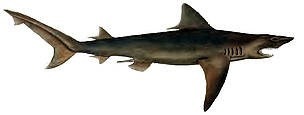
- A rare riverine shark with small eyes, adapted to turbid water.
- Endemic to India and Bangladesh; found in Ganges, Brahmaputra, Mahanadi, Indus, and estuaries.
- Habitat: Tropical rivers and muddy estuaries.
- Threats: Overfishing, pollution, dams, habitat degradation.
- Protection:
- IUCN: CR
- WPA: Schedule I
✅ Hump-backed Mahseer (Tor remadevii)
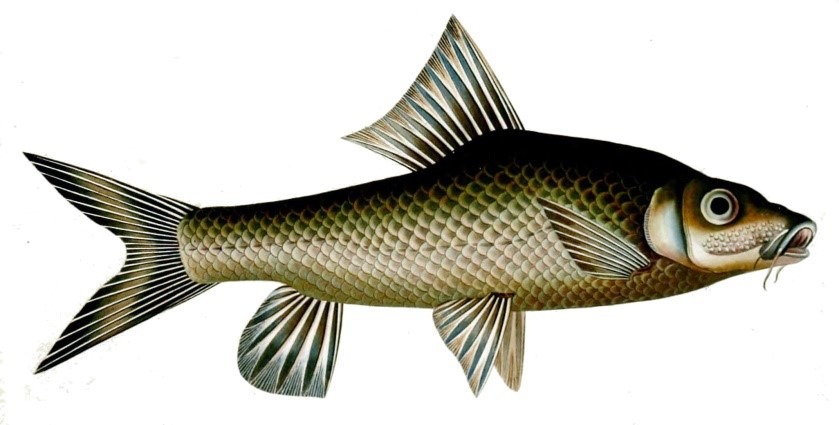
- 🐟 Largest mahseer species, called “Tiger of Cauvery” due to its strength.
- Endemic to Cauvery River Basin, Western Ghats.
- An important bio-indicator of river health.
- Habitat: Inland freshwater streams and wetlands.
- Threats: Dams, destructive fishing, low water flow, pollution.
- IUCN: CR
Endangered (EN)
✅ Golden Mahseer (Tor putitora)
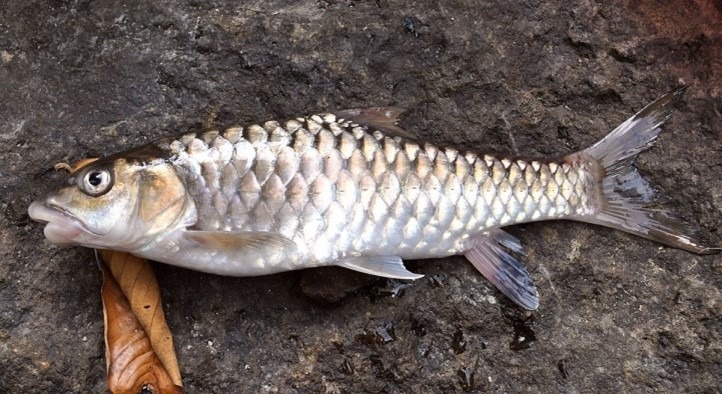
- Known as Himalayan Mahseer or “Tiger of Indian Rivers“.
- State Fish of Arunachal Pradesh, Himachal Pradesh, Uttarakhand, MP, and J&K (UT).
- Distribution: Indus, Ganges, Brahmaputra river basins.
- Habitat: Mountainous streams, rivers, and now lakes/dams.
- Threats: Habitat degradation, pollution, dams, recreational activities.
- IUCN: EN
✅ Wagur (Walking Catfish) (Clarias magur)
- A freshwater air-breathing catfish that can “walk” on land during migration.
- Distribution: India, Nepal, and Bangladesh.
- Habitat: Low-oxygen freshwater and brackish wetlands, flooded rice fields.
- Threats: Overfishing, pollution, invasive/native competition.
- IUCN: EN
Vulnerable (VU)
✅ Helicopter Catfish (Wallago attu)
- Also called Wallago, known regionally as:
- Borali (Assamese), Boal (Bengali), Sareng (Manipuri), Aaththu vaalai (Tamil).
- Distribution: South and Southeast Asia.
- Habitat: Rivers, lakes, and tidal backwaters.
- Threats: Pollution, fishing, natural disasters.
- IUCN: VU
- Also called Wallago, known regionally as:
Least Concern (LC)
✅ Blue Finned Mahseer (Tor khudree)
- Also called Black Mahseer or Deccan Mahseer.
- Distribution: Deccan Plateau and Sri Lanka.
- Habitat: Prefers cool, fast-flowing, rocky streams, but also found in lakes and reservoirs.
- Threats: Dams, overfishing, invasive species, pollution.
- IUCN: LC (recently downgraded from Threatened)
Others
Amphibians of India
Vulnerable (VU)
✅ Kalinga Cricket Frog
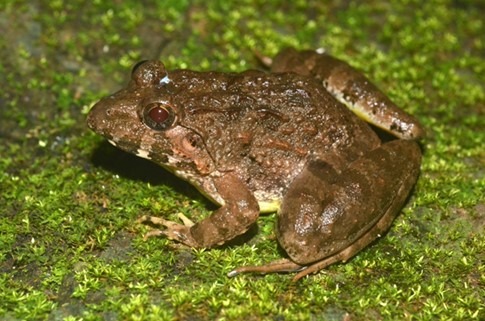
- Endemic to: Eastern Ghats (Odisha & Andhra Pradesh); also found in Western Ghats.
- Habitat: Agricultural fields, streams, swamps, wetlands.
- Indicator Species for ecosystem health.
- Adaptation: Morphological Phenotypic Plasticity – physical changes in response to environmental variation.
- IUCN: VU
Near Threatened (NT)
✅ Purple Frog (Nasikabatrachus sahyadrensis)
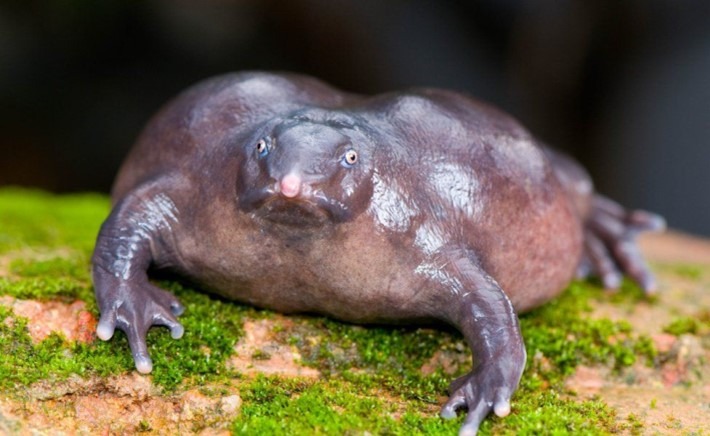
- Ancient species that coexisted with dinosaurs.
- Endemic to: Southern Western Ghats (Kerala).
- Habitat: Montane evergreen forests; lives underground, emerges during early rains for breeding.
- Threats: Habitat loss, tourism, invasive species.
- IUCN: NT
Reptiles of India
Critically Endangered (CR)
✅ Asian Giant Tortoise
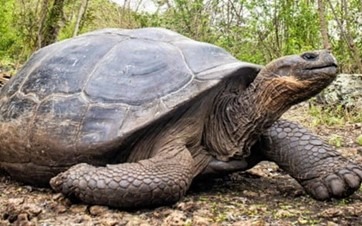
- Largest tortoise species in mainland Asia.
- Distribution: Bangladesh, India, Indonesia, Malaysia, etc.
- Protection:
- IUCN: CR
- CITES: Appendix II
- WPA: Schedule IV
Endangered (EN)
✅ Jeypore Ground Gecko (Cyrtodactylus jeyporensis)

- Endemic to: Eastern Ghats (Southern Odisha, Northern AP).
- Habitat: Below rock boulders in high-altitude semi-evergreen forests.
- Threats: Pet trade, quarrying, mining, forest fires.
- Protection:
- IUCN: EN
- CITES: Appendix II (added in CoP19)
Vulnerable (VU)
✅ Indian Star Tortoise
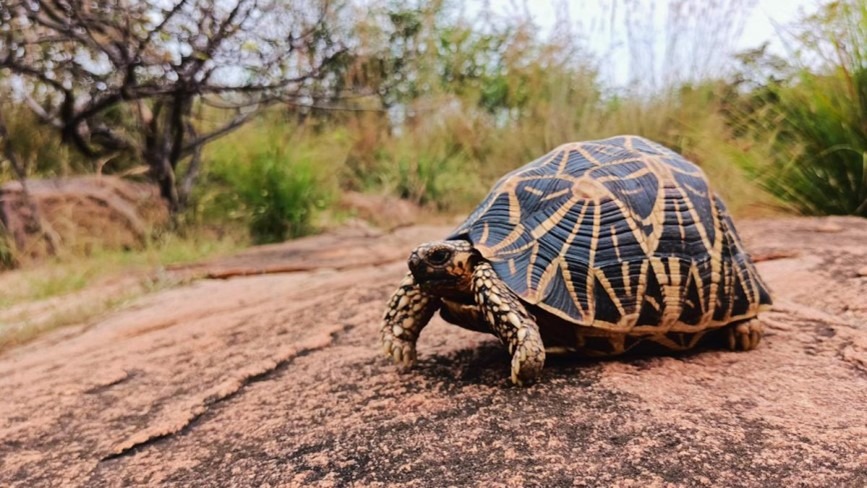
- Habitat: Dry regions south of West Bengal and Gujarat.
- Threats: Pet trade and poaching for meat.
- Protection:
- IUCN: VU
- CITES: Appendix I
- WPA: Schedule IV
Near Threatened (NT)
✅ Sispara Day Gecko
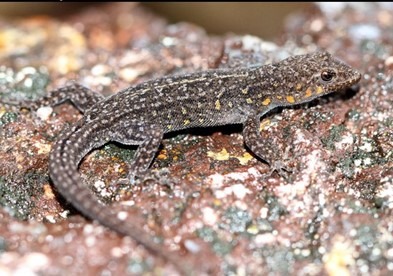
- Endemic to: Nilgiri Hills, Western Ghats (Kerala and Tamil Nadu).
- Habitat: Evergreen to mixed deciduous forests.
- Threats: Habitat loss.
- IUCN: NT
Least Concern (LC)
✅ Indian Golden Gecko
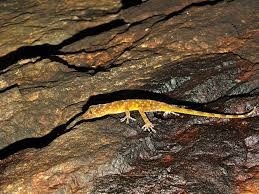
- Also known as Beddome’s golden gecko.
- Endemic to: Eastern Ghats (Odisha, Andhra Pradesh, TN).
- Habitat: Rocky areas, along streams, human habitations.
- Protection:
- IUCN: LC
- WPA: Schedule I
✅ Tokay Gecko
- Distribution: NE India, Bihar, WB; also in Bhutan, China, SE Asia.
- Habitat: Rainforests, rocky cliffs, and human dwellings.
- Threats: Hunting for medicinal use.
- Protection:
- IUCN: LC
- CITES: Appendix II
Data Deficient (DD)
✅ Assam Keelback (Peal’s Keelback)
- A non-venomous snake from the Colubridae family.
- Rediscovered after 129 years in Arunachal Pradesh-Assam border.
- Habitat: Lowland tropical evergreen forests.
- Distribution: Endemic to NE India.
- IUCN: DD
🕷Spiders of India
Critically Endangered (CR)
✅ Peacock Tarantula (Gooty Tarantula)
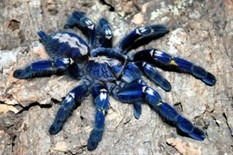
- Also called Metallic Tarantula.
- Color: Striking blue.
- Endemic to: Nallamala Hills, Eastern Ghats (AP).
- Habitat: Dry deciduous forests.
- Threats: Illegal exotic pet trade.
- Protection:
- IUCN: CR
- CITES: Appendix II
✅ Rameshwaram Parachute Spider
- Endemic to: Rameshwaram Island (Tamil Nadu).
- Habitat: Savannah, lowland forests, plantations, human habitations.
- Threats: Habitat fragmentation, tourism.
- Protection:
- IUCN: CR
- CITES: Appendix II
Insects of India
Endangered (EN)
✅ Migratory Monarch Butterfly
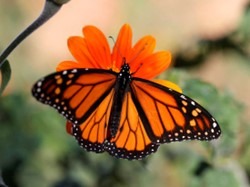
- Famous for 4,000 km migration between N. America and Mexico.
- Breeds only on: Milkweed plants.
- Distribution: Native to N. America and Oceania, reported in Indian subcontinent, Central Asia, Europe.
- Ecosystem Role: Pollinator and supports global food web.
- Threats: Habitat loss, milkweed removal, climate change.
- Protection:
- IUCN: EN
- CMS: Appendix II
Least Concern (LC)
✅ Golden Birdwing
- India’s largest butterfly (replacing Southern Birdwing).
- Distribution: Himalayan regions of NE India and North India.
- Habitat: Forests and scrublands.
- Protection:
- IUCN: LC
- CITES: Appendix II
Threatened & Endemic Plants of India
Critically Endangered (CR)
✅ Eulophia obtusa (Ground Orchid)
- Type: Rare orchid species.
- Distribution: Bangladesh, North India, Nepal.
- Rediscovery: After 118 years in Dudhwa Tiger Reserve, UP.
- Habitat: Seasonal grasslands.
- Protection:
- IUCN: CR
- CITES: Appendix II
✅ Indian Bdellium-Tree (Commiphora wightii)
- Produces fragrant resin known as Guggul, widely used in Ayurveda.
- Distribution: Native to Western India and parts of Pakistan. Found mainly in Gujarat and Rajasthan.
- Habitat: Semi-arid regions; grows in poor soils.
- Uses: Anti-inflammatory resin; used in incense, perfumes, and traditional medicines.
- Threats: Livestock grazing, logging, invasive species, and fungal diseases.
- IUCN: CR
✅ Pyrostria lalji
- Belongs to the coffee family; identifiable by a tall stem with whitish trunk coating.
- Distribution: Originally endemic to Madagascar; recently discovered in South Andaman (Wandoor forest).
- Habitat: Tropical wet evergreen forests.
- IUCN: CR
Endangered (EN)
✅ Globba andersonii (Dancing Ladies / Swan Flower)
- A narrowly endemic plant found only in the Teesta River Valley.
- Distribution: Darjeeling and Kalimpong (WB) and Sikkim.
- Habitat: Grows as lithophyte (on bare rocks) near evergreen forests.
- IUCN: EN
Near Threatened (NT)
✅ Chenkurinji (Gluta travancorica)
- Endemic tree species; namesake of Shenduruny Wildlife Sanctuary.
- Distribution: Western Ghats – Agasthyamalai Biosphere Reserve, TN & Kerala.
- Habitat: Wet evergreen forests.
- Medicinal Use: Used to treat high blood pressure and arthritis.
- Threats:
- Climate change → shifts flowering seasons
- Inbreeding depression
- Inefficient pollination
- IUCN: NT
Miscellaneous Notable Plants
Blue Poppy (Meconopsis spp.)
- Known as “Queen of Himalayan Flowers”.
- Significance: National Flower of Bhutan; contains narcotic alkaloids; roots are poisonous.
- Distribution: Himalayan regions – India (from Kumaon to Kashmir), Tibet, Myanmar, China.
- Abundance in: Hemkund Sahib Lake and Valley of Flowers (Uttarakhand).
- Habitat: Rock crevices, high-altitude hill slopes.
✅ Glycosmis albicarpa
- A gin berry species with large white fruit and distinct gin-like aroma.
- Distribution: Endemic to the Western Ghats (discovered in Kanyakumari WLS, TN).
- Habitat: Evergreen small tree; grows as undergrowth in semi-evergreen forests.
- Uses: Edible and aromatic; attracts biodiversity (pollinators/frugivores)
Plant – Misc – Indian Rosewood (VU) vs North Indian Rosewood (LC)
Feature | Indian Rosewood (Dalbergia latifolia) | North Indian Rosewood (Dalbergia sissoo) |
Common Name | Indian Rosewood | North Indian Rosewood / Shisham |
Native Range | Peninsular India (South & Central India) | Northern India, Nepal, Pakistan |
Habitat | Moist deciduous forests | Riverbanks, foothills, drier regions |
Tree Type | Medium to large deciduous tree | Medium-sized deciduous tree |
Wood Characteristics | Dense, dark hardwood; aromatic; high value | Tough, coarse-textured wood; less aromatic |
Uses | Premium furniture, musical instruments, veneers | Furniture, agricultural tools, boats |
Conservation Status | Vulnerable (VU) – IUCN | Least Concern (LC) – IUCN |
Protection | CITES Appendix II (regulated trade) | Not listed in CITES |
Threats | Over-exploitation, habitat loss, illegal logging | Invasive pests, habitat changes |
Indian Sandalwood vs Red Sandalwood
Feature | Indian Sandalwood (Santalum album) | Red Sandalwood (Pterocarpus santalinus) |
Botanical Family | Santalaceae | Fabaceae |
Genus | Santalum | Pterocarpus |
Order | Santalales | Fabales |
Common Names | Chandan, Srigandha | Lal Chandan, Raktachandan |
Distribution | Native to Southern India and Southeast Asia | Endemic to the Southern Eastern Ghats (Andhra Pradesh) |
Habitat | Dry deciduous forests, scrublands, and plantations | Tropical dry deciduous forests and degraded hilly terrains |
Tree Characteristics | Small to medium-sized evergreen tree with fragrant heartwood | Medium-sized deciduous tree with dark red heartwood |
Wood Type & Color | Pale yellowish-brown, fine-grained, aromatic wood | Deep red, hard and heavy wood |
Fragrance | Highly aromatic, used in perfumes, incense, cosmetics | Not fragrant; valued for its deep red color and medicinal properties |
Cultural & Religious Use | Widely used in Hindu rituals, Ayurvedic medicine, perfumes, and cosmetics | Traditionally used in Chinese medicine and Ayurvedic preparations |
Medicinal Use | Treats skin diseases, anxiety, urinary tract infections, etc. | Antipyretic, anti-inflammatory, used for treating skin ailments and ulcers |
Threats | Overharvesting, illegal logging, habitat loss, Sandalwood Spike Disease (SSD) | Illegal trade, habitat degradation, poor regeneration |
Diseases | Sandalwood Spike Disease (SSD) caused by phytoplasma; spreads via insect vectors | Less susceptible to such systemic diseases |
Conservation Status | Vulnerable (VU) – IUCN | Endangered (EN) – IUCN |
Protection Measures | Controlled under Karnataka Forest Act, Tamil Nadu Forest Act; export regulated | CITES Appendix II |
Economic Value | Extremely valuable for essential oil extraction | Highly priced for use in traditional medicine and red dyes |
Additional Insights:
- Taxonomic Distinction: Despite the name similarity, both species are not closely related taxonomically.
- Indian Sandalwood is a true sandalwood, rich in santalol (fragrant oil compound).
- Red Sandalwood lacks fragrance and is more closely related to rosewood and legumes.
- Sustainability Focus:
- Both species face high pressure from illegal trade and habitat loss.
- Red sandalwood is a major target of smuggling networks, particularly from the Seshachalam Hills of Andhra Pradesh.
- Taxonomic Distinction: Despite the name similarity, both species are not closely related taxonomically.
Sandalwood Cultivation in India
Legal Background
- Pre-2002: Cultivation of sandalwood (both white sandalwood – Santalum album – and red sandalwood – Pterocarpus santalinus) by private individuals was prohibited.
- Post-2002: Several states have amended forest laws to permit private cultivation of sandalwood under regulated conditions.
Current Legal Framework
- Although cultivation is allowed, the harvesting, sale, and transportation of sandalwood is strictly controlled.
- Permission from the State Forest Department is mandatory to:
- Cut down sandalwood trees
- Sell or transport harvested wood
- The Forest Department typically conducts the harvesting, after which it buys the wood at a government-fixed rate.
- Open market sale is illegal, especially for Indian sandalwood (Santalum album).
Challenges & Consequences
- Due to these regulatory bottlenecks, very few individuals or farmers choose to cultivate sandalwood.
- Contrast with global practices:
- Countries like Australia, Indonesia, and Sri Lanka have liberal cultivation and export rules, giving them a competitive edge in the global sandalwood trade.
- Impact on India:
- Hinders the growth of a potentially lucrative agro-forestry sector.
- Impairs India’s ability to conserve and replenish its native sandalwood population through private efforts.
- Affects the global share and competitiveness of Indian sandalwood in international markets.
Sandalwood Spike Disease (SSD)
What is SSD?
- Sandalwood Spike Disease (SSD) is a lethal plant disease caused by phytoplasmas, which are wall-less bacterial pathogens.
- These phytoplasmas infect the vascular tissue of plants, disrupting nutrient flow.
Host Plants Affected
- Apart from Indian sandalwood, phytoplasmas are known to infect:
- Sugarcane
- Coconut
- Other economically important crops
- Apart from Indian sandalwood, phytoplasmas are known to infect:
Why is SSD Alarming?
- Considered the most destructive disease affecting Indian sandalwood (Santalum album).
- Leads to stunted growth, leaf discoloration, spike-shaped shoots, and eventually death of the tree.
- No known cure exists currently, and control measures mainly rely on removal of infected trees and vector management.
Transmission
- SSD is transmitted by sap-sucking insect vectors, such as leafhoppers, which carry the pathogen from one plant to another.
Research & Prevention
- Ongoing research is focused on:
- Early diagnosis using molecular tools
- Breeding resistant varieties
- Biological control of vectors
- Ongoing research is focused on:
Invasive Species
Invasive Plant Species in India
Invasive alien species are non-native plants or animals that spread aggressively, often outcompeting native species and disrupting natural ecosystems. They are a major driver of biodiversity loss and ecological degradation worldwide, and India is no exception. Several invasive plants have spread across the country, damaging native flora, impacting agriculture, and even affecting human and animal health.
Acacia (Wattle)
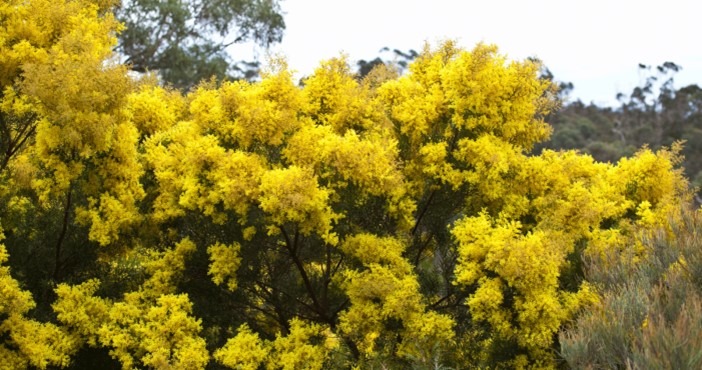
- Origin: Native to Africa and Australasia
- Ecology: Acacia is a drought-resistant, evergreen plant known for its deep root system that allows it to access underground water sources. It has thorny, small leaves that minimize water loss through transpiration, making it highly suitable for arid regions.
- Invasiveness: It reproduces rapidly and forms dense canopies, blocking sunlight and suppressing the growth of native grasses and understory plants.
- Ecological Impact: In the Western Ghats, large-scale plantations of acacia and eucalyptus were raised for tannin production, replacing native grasslands and shola forests, which are critical habitats for species like the Nilgiri Tahr, leading to habitat destruction and biodiversity decline.
- Utility: Acacia bark, pods, and leaves contain tannins, which are organic compounds used in the leather tanning industry.
Billygoat Weed (Ageratum conyzoides)
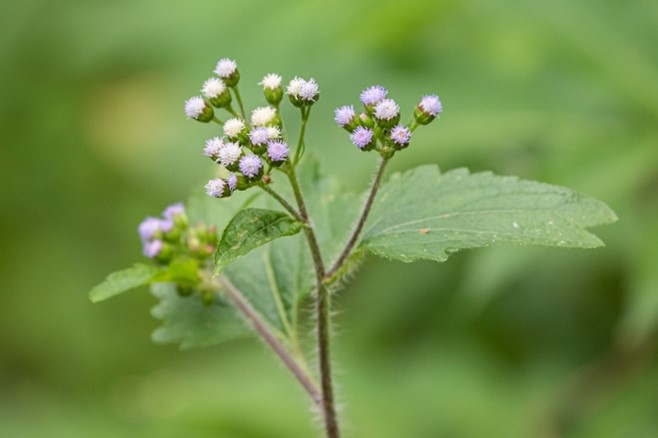
- Origin: Native to Tropical America, especially Brazil
- Uses: It has been traditionally used for its medicinal properties, particularly in folk medicine. It also exhibits insecticidal and nematicidal properties.
- Invasiveness: Outside its native range, it has become an aggressive weed, particularly in rice-growing regions of Asia.
- Ecological Impact: It competes with crops and native species, making it a moderate weed of economic concern in agricultural landscapes.
Carrot Grass (Parthenium hysterophorus)
- Other Names: Congress grass, Famine weed
- Origin: Native to tropical America
- Invasiveness: One of the most problematic invasive species in India, it spreads rapidly in open lands, roadsides, farmlands, and wastelands.
- Ecological Impact: It releases allelopathic chemicals that inhibit the germination and growth of other plants, causing major crop losses.
- Human & Animal Health: Its airborne pollen and volatile chemicals can cause severe allergies, asthma, dermatitis, and respiratory issues in humans. It is also toxic to livestock, leading to dermatitis and poisoning.
- Policy Note: Carrot grass is listed as a noxious weed under various state-level agriculture acts, but effective eradication remains a challenge.
Eucalyptus
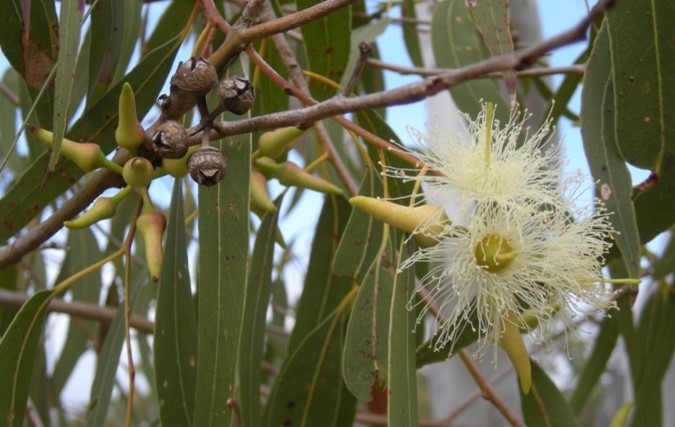
- Origin: Native to Australia
- Characteristics: A fast-growing evergreen tree, eucalyptus has medicinal properties—its oil is used for respiratory issues, pain relief, dental care, and as an insect repellent.
- Invasiveness: Outside its native range, it grows rapidly and dominates landscapes by altering soil chemistry and suppressing the growth of native vegetation.
- Ecological Impact: It consumes large amounts of water and reduces groundwater levels, negatively impacting local fauna, especially fodder-dependent herbivores.
- Controversy: Although useful for timber and oil, eucalyptus monocultures are often discouraged in ecologically sensitive areas like the Western Ghats.
Forked Fanwort (Cabomba furcata)
- Origin: Native to South America
- Description: A pink-flowering, submerged aquatic plant, often used in aquariums due to its ornamental appeal.
- Invasiveness: It thrives in stagnant or slow-flowing freshwater bodies and can quickly colonize ponds and lakes.
- Ecological Impact: It outcompetes native aquatic flora, forming dense mats that affect oxygen levels, water flow, and the habitat of aquatic organisms.
Lantana camara
- Origin: Native to American tropics
- Invasiveness: One of the most widespread and resilient invasive shrubs in India. Once introduced, it spreads uncontrollably, even in degraded ecosystems.
- Ecological Impact:
- Reduces biodiversity by choking native plants.
- Invades forests and farmlands, leading to pasture degradation.
- Its toxic leaves and stems are poisonous to livestock, further affecting rural livelihoods.
- Conservation Concern: Lantana’s spread is a major obstacle in habitat restoration and is considered a threat to wildlife corridors in national parks and sanctuaries.
Mexican Prickly Poppy (Argemone mexicana)
- Origin: Native to Mexico
- Ecology: An annual herb that tolerates drought, poor soil, and disturbed areas. It grows along roadsides, floodplains, and agricultural fields.
- Invasiveness: Competes aggressively with native flora and affects soil fertility.
- Health Impact: Its seeds resemble mustard seeds and are sometimes used as adulterants, making the edible oil toxic. It has been linked to epidemics of dropsy and other health disorders.
- Regulatory Note: It is a regulated weed species, and efforts are ongoing to identify contaminated food products.
Mikania micrantha
- Common Names: Mile-a-minute weed, Bittervine
- Origin: Native to Central and South America
- Description: Mikania micrantha is a fast-growing, tropical, perennial creeper. It thrives in areas with high humidity, abundant sunlight, and fertile soils, although it is also capable of adapting to less fertile conditions. Its feathery seeds are lightweight and wind-dispersed, aiding its rapid spread.
- Invasiveness: It is considered one of the world’s worst invasive plant species. It spreads aggressively and chokes other vegetation, blocking sunlight and hindering the germination and growth of other plants.
- Ecological Impact: Originally introduced to India in the 1940s as a ground cover in tea plantations, Mikania micrantha has now spread widely, becoming a major threat to plantation crops (especially tea, coffee, and rubber), natural forests, and biodiversity-rich ecosystems.
- Medicinal Use: Traditionally used for wound healing and to stop minor bleeding, though its benefits are far outweighed by its ecological harm.
- Control Measures: Manual removal, use of bio-control agents like Puccinia spegazzinii (a rust fungus), and preventing its spread through early detection and rapid response (EDRR) are common strategies.
Prosopis juliflora
- Common Names: Ganda Babool, Vilayati Keekar
- Origin: Native to Mexico, South America, and the Caribbean
- Description: A small thorny tree with a deep root system, Prosopis juliflora is highly drought-resistant and can thrive in arid and semi-arid environments. It was initially introduced in India for afforestation, fuelwood, and desertification control.
- Invasiveness: It grows aggressively, forming dense thickets that outcompete native flora. Its long tap roots extract large amounts of underground water, exacerbating water scarcity in dryland areas.
- Ecological & Social Impact:
- It blocks wildlife corridors, obstructing animal movement.
- Increases malaria risk as it provides sugar sources for Anopheles mosquitoes, enhancing parasite transmission.
- Invaded the Banni grasslands of Gujarat after being introduced to fight salinity and desert expansion. It flourished in low-salinity areas, displacing native grasses critical for Maldhari pastoralists, thereby reducing grazing lands.
- Economic Use: Unexpectedly, the wood has found use in charcoal production due to its high carbon content, providing a source of livelihood for some rural communities.
- Management Challenge: Its dual nature—invasive and economically useful—makes eradication efforts politically and socially complex.
Water Hyacinth (Eichhornia crassipes)
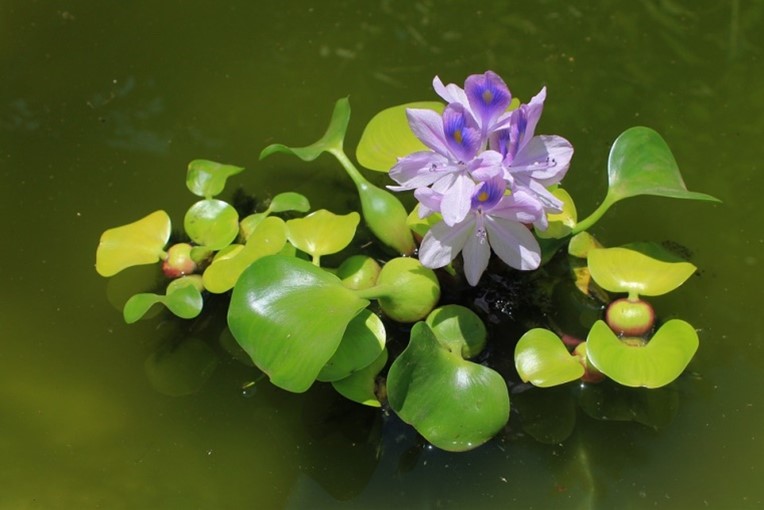
- Origin: Native to South America
- Description: A free-floating aquatic plant (hydrophyte), water hyacinth grows in ponds, lakes, rivers, and canals, and is characterized by broad leaves, purple flowers, and spongy stems. It is capable of surviving in a wide range of climates including tropical, subtropical, and temperate zones.
Nicknames:
- “Terror of Bengal” – India
- “German Weed” – Bangladesh
- “Florida Devil” – South Africa
- “Japanese Trouble” – Sri Lanka
- Invasiveness: Water hyacinth reproduces both vegetatively and sexually, forming thick mats that can cover entire water surfaces.
- Ecological Impact:
- Blocks sunlight penetration, affecting submerged plant life.
- Depletes oxygen in water bodies, causing mass fish deaths and biodiversity loss.
- Clogs waterways, impeding navigation, irrigation, and fishing.
- Enhances mosquito breeding, raising the risk of vector-borne diseases like dengue and malaria.
- Management:
- Manual and mechanical removal
- Use of biological agents (like the weevil Neochetina eichhorniae)
- Promotion of utilization strategies (e.g., converting biomass into biofertilizers, biogas, or handicrafts)
Invasive Fish and Amphibian Species
Invasive Fauna in India – Aquatic and Amphibian Species
African Catfish (Clarias gariepinus)
- Origin: Native to Africa and parts of the Middle East
- Category: Air-breathing catfish, a unique group of fish species capable of surviving out of water for short durations by breathing atmospheric oxygen.
- Adaptation: These fish can “walk” across land by wiggling their bodies in search of food or more suitable aquatic environments, especially during dry spells.
- Habitat:
- Found in freshwater lakes, rivers, swamps, and polluted water bodies
- Tolerant to low-oxygen levels, turbidity, and pollution, making it a survival specialist in extreme aquatic conditions
- Ecological Threat:
- The African catfish is a voracious predator that feeds on smaller fish, amphibians, and aquatic invertebrates.
- It has been illegally introduced and cultivated in India in contaminated ponds and urban lakes, where it outcompetes and preys upon native fish species, leading to a sharp decline in indigenous biodiversity.
- Regulation in India:
- Due to its invasive nature and associated health and environmental hazards, the Government of India imposed a ban in 2000 on its farming, transportation, and sale.
- Despite the ban, illegal rearing persists in several states due to its fast growth and high market demand.
- Conservation Note: Its continued presence poses a long-term threat to the ecological balance of freshwater ecosystems and livelihoods of traditional fishers who depend on native species.
Indian Bullfrog (Hoplobatrachus tigerinus)
Description:
- One of the largest frog species in India, characterized by its bright yellow coloration during breeding season and distinctive deep croaking calls.
- Native to the Indian subcontinent – including mainland India, Sri Lanka, Nepal, and Bangladesh.
- One of the largest frog species in India, characterized by its bright yellow coloration during breeding season and distinctive deep croaking calls.
Invasiveness:
- While native to mainland India, the Indian bullfrog has become invasive in certain island ecosystems where it was artificially introduced, such as:
- Andaman and Nicobar Islands (India)
- Maldives
- Madagascar
- In these regions, it has no natural predators, and its high reproductive rate enables it to spread rapidly.
- While native to mainland India, the Indian bullfrog has become invasive in certain island ecosystems where it was artificially introduced, such as:
Ecological Threat:
- Feeds on a wide range of fauna including small mammals, fish, lizards, insects, and other amphibians.
- Its presence leads to drastic reduction in native frog populations and disruption of local food chains.
- Also competes with native predators and amphibians for habitat and food.
Conservation Implication:
- Island ecosystems are ecologically fragile, and the bullfrog’s introduction has caused irreversible damage in some areas.
- Control efforts are challenging due to its adaptability and high breeding success.


